BROOKLYN EASTERN
DISTRICT TERMINAL,
EAST RIVER TERMINAL RAILROAD
& PALMER'S DOCK
.
Steam & Diesel Locomotive, Non- Revenue Equipment & Marine Equipment Specifications & Rosters
..
.

.
for Locomotives, Marine Equipment &
Non-Revenue Equipment
|
||||||||||||||||
IMAGES & FILM | ||||||||||||||||
|
||||||||||||||||
Locomotives:
|
||||||||||||||||
 |
![[Image]](http://members.trainweb.com/bedt/bedt/8.gif) |
 |
 |
 |
 |
 |
 |
 |
 |
|||||||
| . | ||||||||||||||||
| . | ||||||||||||||||
This chapter touches upon the various
nuances of the the locomotives used by the BEDT. It will outline similarities
and the basic histories of the designs. If you desire in depth information
of all or any one locomotive, I recommend you visit the roster pages below
as well as footnotes, where the technical details and specifications are
listed.
BEDT operated a fleet of compact but powerful Steam Locomotives
known as "sidetankers" and "saddletankers". These locomotives were also known
as "Drill Engines", "Docksiders", and in Europe, they are known as "Tank
Engines"; (e.g: Thomas the Tank Engine). Over the period of its 113 year
existence, Palmer's Dock, East River Terminal and the Brooklyn Eastern District
Terminal would come to own sixteen steam locomotives, comprised of 0-4-0T
and 0-6-0T side and saddletankers:
Frederick Havemeyer, #2, #3, #4, #5, #6, #7, #8, #9, #10, #11, #12, #13, #14, #15, and #16
All of BEDT's locomotives had the distinction of being able to operate without a tender (as all tank engines do). As regular steam locomotives hauled a tender behind the engine which carried fuel (wood, coal or oil) and water for the locomotive. Since operating space on carfloats and the tight radii (curves) of yard & street trackage was at a premium, a small bunker on the rear of the locomotive carried the fuel and a water tank was mounted on the sides of, or "draped" over the top of the boiler (like a horse saddle); hence the name "saddletank".
Furthermore, as the locomotives were to
remain within a short distance to the shop, they could be refueled more
frequently, and therefore it was not necessary for the locomotive to carry
a large supply of fuel and / or water as it would have to were it to
go long distances between refueling. Lots of yard and shop locomotives for
the larger railroads used this saddletank arrangement to much success.
Due to this configuration, unlike conventional
steam locomotives which required a engineer to run the locomotive and
a fireman to feed fuel, the oil fired steam switchers used on the BEDT
were equipped for one man operation.
The earliest of these locomotives ("Frederick Havemeyer", and
#2 through 7) that ran for Palmer's Dock, East River Terminal and then
the Brooklyn Eastern District Terminal, as stated earlier; were equipped
with dummy street car shells over the locomotive. Hence the name "Dummy Engines",
"Street Dummies" or "Steam Dummies". This design was to prevent frightening
of horses, as horses were supposedly comfortable with and used to streetcars
/ trolleys, but were easily frightened by steam locomotives. Go figure!
Naturally as the internal combustion engine replaced horses,
(and as they aren't afraid of steam locomotives) the street dummies were
no longer necessary. It is now known, by referencing the image of the
East River Terminal / Brooklyn Eastern District Terminal that appeared in
April 6, 1914 issue of "Greater New York" (a weekly bulletin published by
the Merchants Association of New York); a locomotive can be seen without
the street car shell operating for the East River Terminal Railroad / Brooklyn
Eastern District Terminal. Whether all of the ERT / BEDT locomotives had
their street car shells removed by this date, or only a select few retained
their street car shells and likewise to what date, remains undetermined at
this time. This image may be viewed in the East River Terminal chapter on
the main website under the subchapter "ERT Property Photo". By the time the
Terminal was reconstructed in 1918, as evidenced by the W. R. Harrison series
of images, the steam dummy carbodies were no longer in use on any of the
locomotives, despite the fact that horses were still prevalent for pulling
wagons and many are on property attached to wagons seen being loaded or unloaded.
The following images are zoom & crops taken from the W.
R. Harrison Reconstruction Photos, taken 1918 through 1919. While the locomotives
were in the background of the images, the large size of the image (7" x 9)
permitted some use. Unfortunately, the locomotive numbers cannot be discerned,
but on least one, the 0-6-0T wheel arrangement and shape of the numeral is
#8. Also all appear to be coal fired but the low, open style of bunker, and
none of the locomotives are "wearing" a steam dummy carbody.
|
|
|
| . . |
. . . |
|
|
. |
|
| . . |
||
|
|
|
all images: W. R. Harrison - 1918, 1919 |
||
Also discovered; if one takes the time to compare the Baldwin
builder photo of BEDT #11 and then the picture directly below it; you will
notice that in the builders photo, #11 has a short style open topped coal
bunker. In the second photo, it is clearly obvious that #11 had been modified
to have a tall style closed top bunker to hold oil! Likewise, the picture
of #8 shows her being scrapped as a coal burner in 1933. Yet the photo of
#7 has a high style oil bunker at the same usage period (1933/1934). The
photo of #9 as well shows a tall style oil bunker, yet was built prior
to #10 and #11; of which #11 was already discussed being seen with both coal
and oil.
So, all things being considered, Baldwin built locomotives
"Frederick Havemeyer", and 2 through 11 appear to have been originally built
by Baldwin as coal fired; and at the least, numbers 6, 7, 9, 10 & 11
were converted to burn oil by BEDT (with 8 being scrapped as a coal burner)
sometime after the turn of the century.
H. K. Porter Boiler Record documents recently coming to light,
show that H. K. Porter built numbers 12 and 13 (c/n 6368 and 6369) were built
as coal fired for their first owner, the US Navy Fleet Supply Base in South
Brooklyn (not the Navy Yard). As some point in their life, most likely (but
unconfirmed) they were converted to oil when BEDT purchased them or shortly thereafter.
Numbers 14 and 15, were built as coal fired when built for Mesta Machine Works and converted to oil fired by
BEDT when they were purchased as well. The builders picture of #16 shows
a tapered style coal bunker as well. Considering that Astoria Light, Heat
& Power utilized coal for their gasification plants, it only seem logical
their locomotives were fired by coal as well, but it is unknown whether it
was converted to oil fired by its second owner (Fleischmanns Yeast of Peekskill,
NY) or by BEDT. In all likelihood, the locomotive was converted by BEDT as
they had the experienced shop forces to modify the locomotive.
Those BEDT steam locomotives that were converted to burn oil,
utilized Bunker-C oil. While Bunker-C is considered a "heavy" type of oil,
(when compared to #2 fuel oil or diesel fuel), there is a sound reasoning
for it's use. The second generation of steam powered tugboats of which the
BEDT operated, were also fired with Bunker-C. It was cheap and widely available,
so it was naturally cost efficient to run all the equipment tugboats and
locomotives alike, with one fuel. The use of Bunker-C oil in their locomotives
also allowed the railroads to eliminate the fireman's position in locomotive
operation, as an employee was no longer needed to shovel coal into the firebox.
The oil could be controlled via the use of simple valves.
Bunker Fuel received its name from the containers or tanks
on ships which are known as "Bunkers", of which the fuel is stored in. In
the days of steam power, the bunkers originally held coal, and these bunkers
were either converted by enclosing or built from the start to hold liquid
fuel as those liquid fuels became more common. Bunker-C oil, which got its
name from the Navy fuel specification, is also known as "Number 6 Fuel Oil",
"Residual Fuel Oil (RFO)", or by the Pacific Specification of "PS-400".
A residual oil is an oil product that remains after the more
valuable "cuts" of crude oil such as naphtha, gasoline, etc; have boiled
off. This oil residue may contain various undesirable impurities including
2 percent water and ½ percent mineral soil.
Residual oils also contain relatively high amounts
of pollutants, particularly sulfur; which forms sulfur dioxide upon combustion.
Despite this, Bunker-C is still a cleaner burning fuel than coal. Even
due to those undesirable properties, Bunker Fuels are very cheap, and in
fact it is the cheapest liquid fuel available.
However, there are downsides to using Bunker-C oil. It must be pre-heated to 150° F to 250° F
before it can be pumped easily. This requires a correctly designed system
for storage, pumping and burning, as in cooler temperatures the Bunker-C
oil can congeal into a tar-like semi-solid. Keeping Bunker-C Fuel flowing
is usually accomplished by a recirculated low pressure steam system which
pre-heated the fuel to allow it flow easier.
This necessary pre-heating precluded this fuels' use in smaller
vehicles such as automobiles or boats, as the pre-heating equipment would
take up valuable space and make the vehicle heavier. Therefore, Bunker-C
oil was better suited as a fuel for steam boilers (for making heat and/or
generating electricity), steamships, and steam locomotives. As these large
applications both generated heat and could take that heat from the combustion
process to heat the fuel prior to firing and if necessary, be large enough
to house the pre-heating equipment and piping necessary for keeping Bunker-C
oil fluid, it was a sensible fuel choice. The BEDT had a small steam
powered boilerhouse just outside the enginehouse, for both steam heating
of the enginehouse, and to provide steam so the Bunker-C storage cars could
be kept warm as well.
By comparison, while Bunker-C oil releases up to 11% more BTU's
(British Thermal Units) than the equivalent amount of Number 2 Fuel Oil;
Number 2 Fuel Oil does not need to be pre-heated, so it is better suited
for use as a fuel for smaller, more mobile applications; such as diesel-electric
locomotives, cars, trucks and smaller marine vessels. As Number 2 Fuel Oil
is also cleaner burning as it is more refined the Bunker C oil, it releases
less pollutants than Bunker-C; and this helped lead to the elimination of
Bunker-C Fuel as a locomotive fuel.
Despite the disadvantages; the use of Bunker-C by the BEDT must
have been a consideration through the 1950's, as the BEDT continued
to fire their steam switchers on Bunker-C oil even when diesel locomotives
were gaining popularity. But, once the newer tugboats equipped with diesel
engines arrived, the diesel-electric locomotives couldn't be far behind,
and eventually found their way to the BEDT in 1962.
| Also of interest is the fact that
BEDT shops did almost all of their own repairs on the locomotives with few
and far between exceptions. Short of heavy repairs such as a new firebox, it is now obvious that BEDT's mechanical shop forces were experienced, knowledgeable and equipped for most steam locomotive repairs. Several photos now part of this websites collection, show different locomotives in various states of disassembly, repair & refurbishment. Mechanically speaking, it appears the BEDT steam locomotives were extremely well maintained right up until the end of steam locomotive operations. No spit & baling wire repairs or leaky, wheezy steam chests or cylinders on this equipment! Nor was the paint ever flaking or faded, nor were there broken windows in the cabs. Obviously not only were locomotives well maintained mechanically, but superficially as well. Even during the declining rail traffic years of the 1970's, the diesel locomotives were mechanically in good repair. |
|
|
|
. |
|
|
|
| .. | |
|
|
| .
Referencing the image immediately above, BEDT maintenance records reflect that #16 received flues, lagging, hydrostatic test and 23B on March 1, 1962. As Interstate Commerce Commission regulations require inspections and maintenance every four years, therefore it would make sense that #16 would have been shopped four years prior in 1958. As the bottom of the saddletank is still round in the second photo below, it is believed that the photos are of the locomotive being overhauled in late 1958 or early 1959, as it was at this time around 1960 that the square bottoms on the saddletank were welded on.
|
|
|
|
These locomotives appear to be efficient
as well, because if you take note; there are very few images of the locomotives
showing smoke, and consider that we've all seen "modern" diesel switchers
and road engines from Class 1 railroads with more emissions!
Until that sad and fateful day that the diesels took over,
BEDT enjoyed the use of steam locomotives later than any other railroad in
the Northeast (for everyday freight hauling), with steam locomotive operations
officially concluding on October 25, 1963. When you take into consideration
that New York City essentially banned the use of steam locomotives within
the city limits in 1923, one must wonder how BEDT kept steam locomotive
operations around for so long!
Needless to say, the BEDT with it's late usage of steam locomotives,
its easy metropolitan access and railfan friendly atmosphere made it very
popular with railfans and photographers. Try that now in this age of homeland
security paranoia! Just imagine; taking pictures of steam locomotives all
day, then "jumping" across the Williamsburg Bridge to get a salami on club
and Dr. Browns black cherry soda at Katz's Delicatessen.
I also am left to wonder, if BEDT had survived long enough to
benefit from TOFC (Trailer on Flat Car) and COFC (Container on Flat Car)
traffic, would the venture be known as "BEDTIME"? Brooklyn
Eastern District Terminal
InterModal Exchange - get it? Haha!
:o)
Unfortunately, all Baldwin built sidetankers (the Frederick C. Havemeyer,
and numbers 2 through 11) were scrapped by BEDT, with 10 & 11 being scrapped
as late as 1962 and 1963. However; the remaining five H. K. Porter built
locomotives (numbers 12 through 16) have all been saved and subsequently
sold into private hands, and are currently in various states of restoration,
storage and display. One (#15) is even in operation at Strasburg RR "dressed"
as Thomas the Tank Engine !
In
the process of doing some research on Viscose #6, an 0-4-0T built by
Baldwin Locomotive Works; I posted a question on Railway Preservation
News. One of the responses to my question suggested the information I
sought might be found in the Southern Methodist University
- DeGolyer Library Digital Archives, which is a significant
repository for photos and records from the Baldwin Locomotive Works. I
had visited the digital collection more than a decade ago (2008? 2009?)
but the specification sheets had not been digitized until 2010, and
therefore I missed them.
Naturally, after obtaining the information for Viscose 6, I
commenced to look up the Baldwin built locomotives constructed for the
Brooklyn Eastern District Terminal. This first required learning how to
cross reference the Baldwin index with the corresponding albums and
pages. And there are 83 albums, dating back to 1869, but some years of
large production take up several albums, so it does not correlate to
one year = one album. Also, the pages are not continuously numbered
unbroken. If there was a revision or replacement part or extra order,
that page was slipped in. So, if a locomotive is listed as Album 12,
Sheet 154, it will be in Album 12, but Sheet 154 might be 190 pages in!
Making things more complicated, was that some of the page numbers
(printed in the corners of the sheets) in the albums were missing
or illegible due to dog ears, or age. This would require looking
through an applicable album page by page. Sure enough with due
diligence, I was able to find all the spec sheets for all eleven of the
Baldwin locomotives built for and used by the BEDT.
As usual, there were some revelations! The Frederick C. Havemeyer
was purchased by Havemeyer & Elder, as was #9. Numbers 2, 3, 4, 5,
6, 7, 8 were purchased by Lowell M. Palmer. Numbers 10 and 11 were
purchased by Brooklyn Eastern District Terminal.
The Frederick C. Havemeyer was painted - a yellow exterior (!),
drab interior & tank, black underside, no pinstriping except on the
cylinders and the cab marked "FREDERICK C. HAVEMEYER" and "1876" in no
less than 12" lettering. Following locomotives however were painted two
shades of brown exterior and interior, cylinders brown with black
undersides. Other details worth noting: no headlight and no whistle, on the Frederick as well as following locomotives.
Just about every detail regarding the part and construction of
these locomotives is listed. They contain significantly more
information that that listed on the reverse of the Builders Cards. I am
still rereading the entries and that ornate penmanship can be hard to
read! Also there are paint codes (E6, E11) that I have to learn.
As requested in the main file description, utmost thanks and
gratitude must go to the Southern Methodist University for making these
documents available, and additional thanks to Richard Dunn of
Castro Valley, California for providing the grant in 1982 that allowed
these written records to be photographed to microfiche for railroad
historians to use.
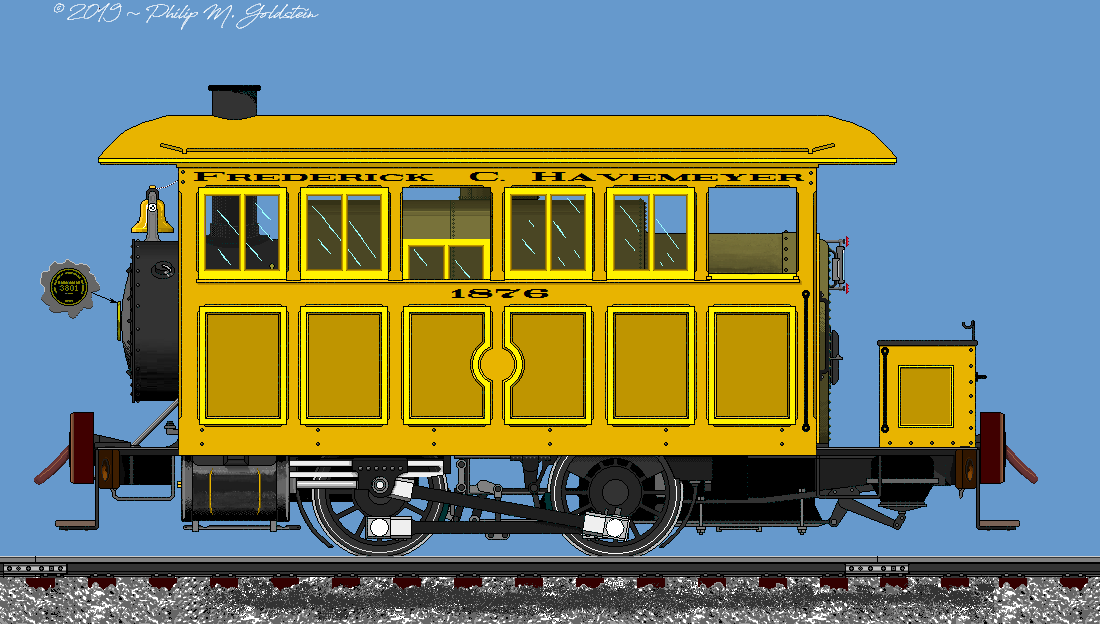
The above and following drawings are the
authors renderings of the Frederick C. Havemeyer and subsequent locomotives.
They are
based on a line drawing of a Baldwin Locomotive Works "Steam
Dummy"
0-4-0T by Joshua Moldover,
heavily modified to the
specifications and by the colors and letters contained in the Baldwin
Locomotive Work Specification Sheets as defined for these locomotive.
.
While not 100 percent accurate without seeing an actual image,
it does give the viewer a fairly decent representation
of the style of locomotive
utilized by Palmer's Dock and the East River Terminal Railroad
at the beginning of operations.
While the Frederick C. Havemeyer was specified with a yellow body, following orders for locomotives #2 through #9 specified two tone brown on the all over cab.
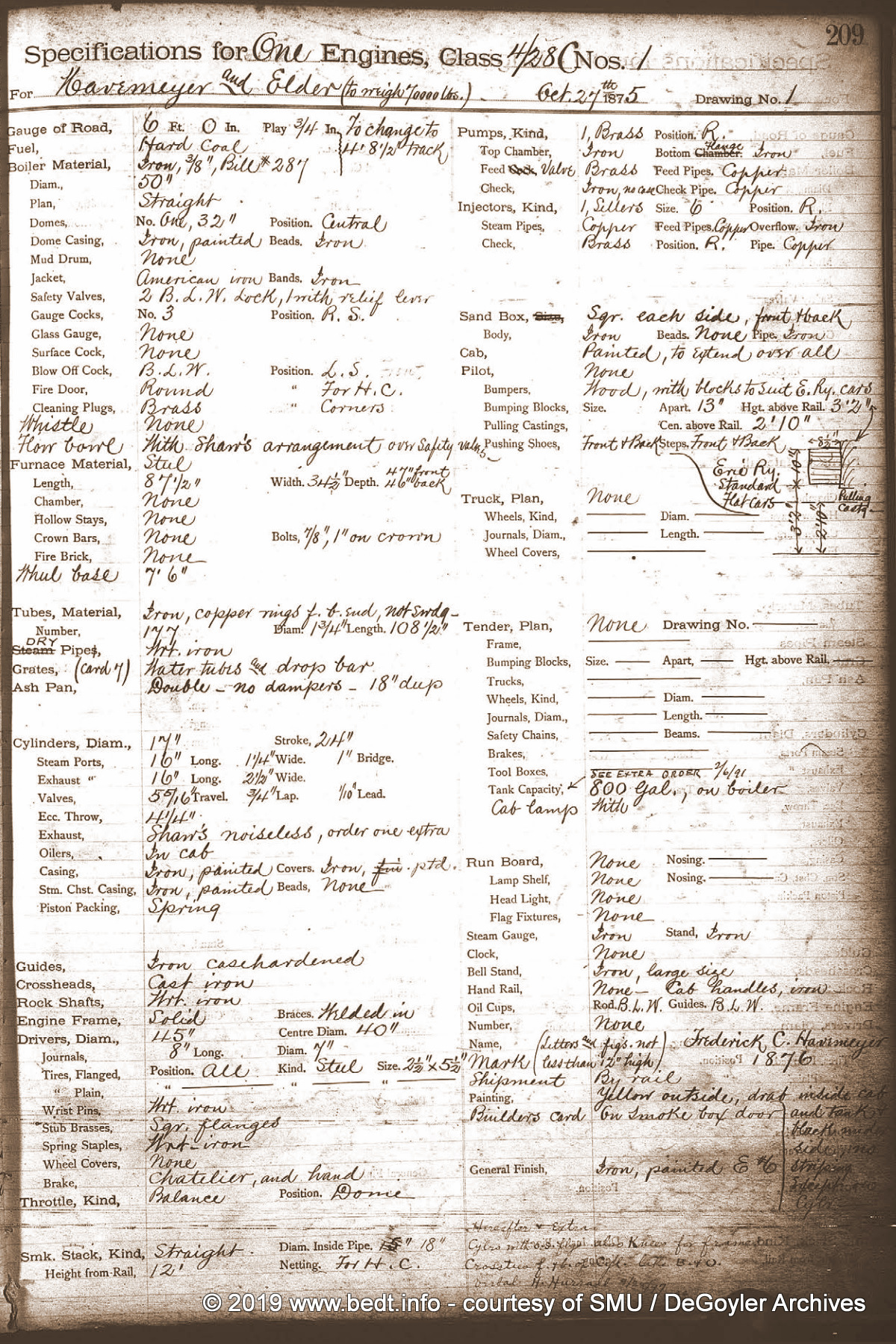 "Frederick C. Havemeyer" (#1) |
| . . |
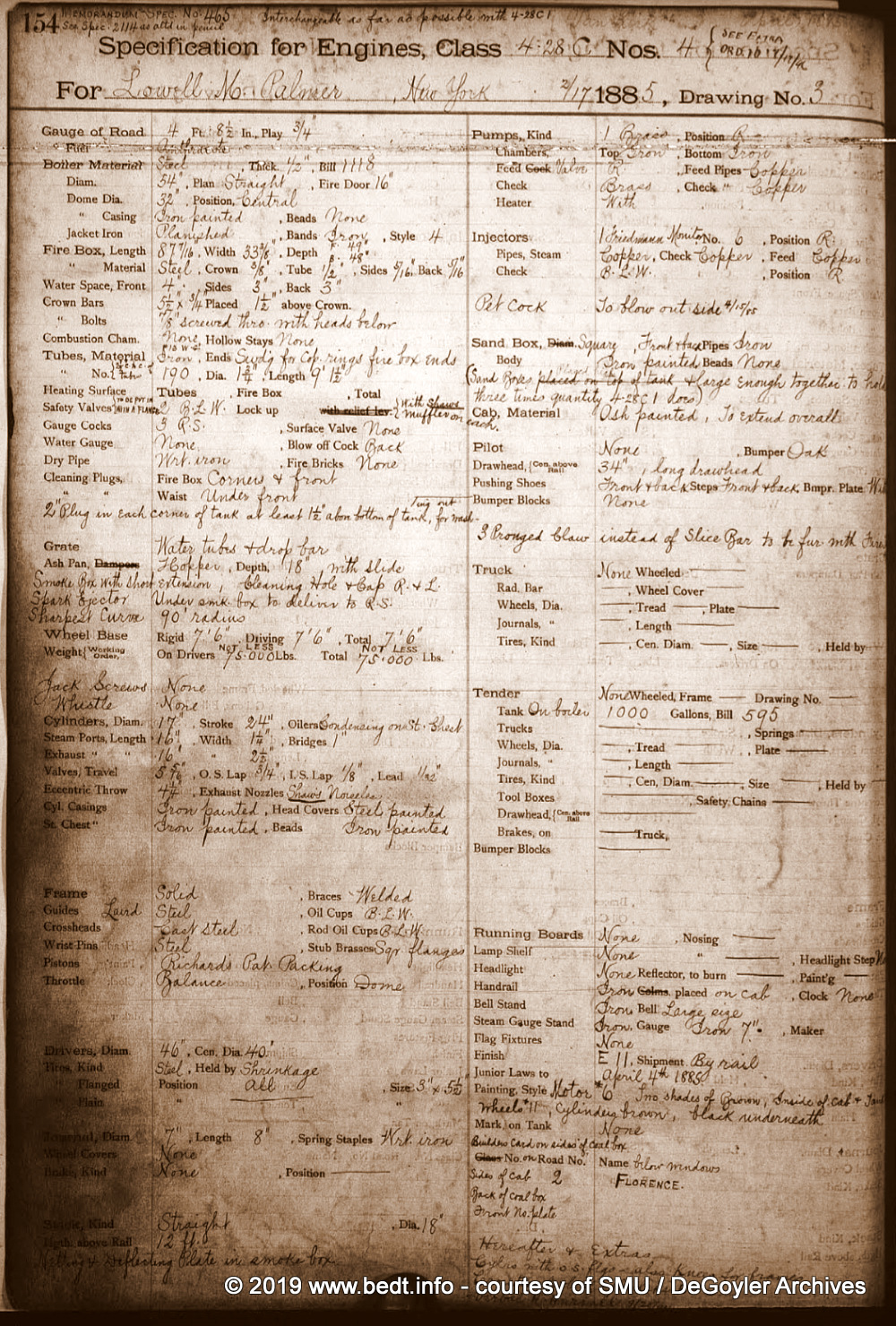 #2 "Florence" |
| . . |
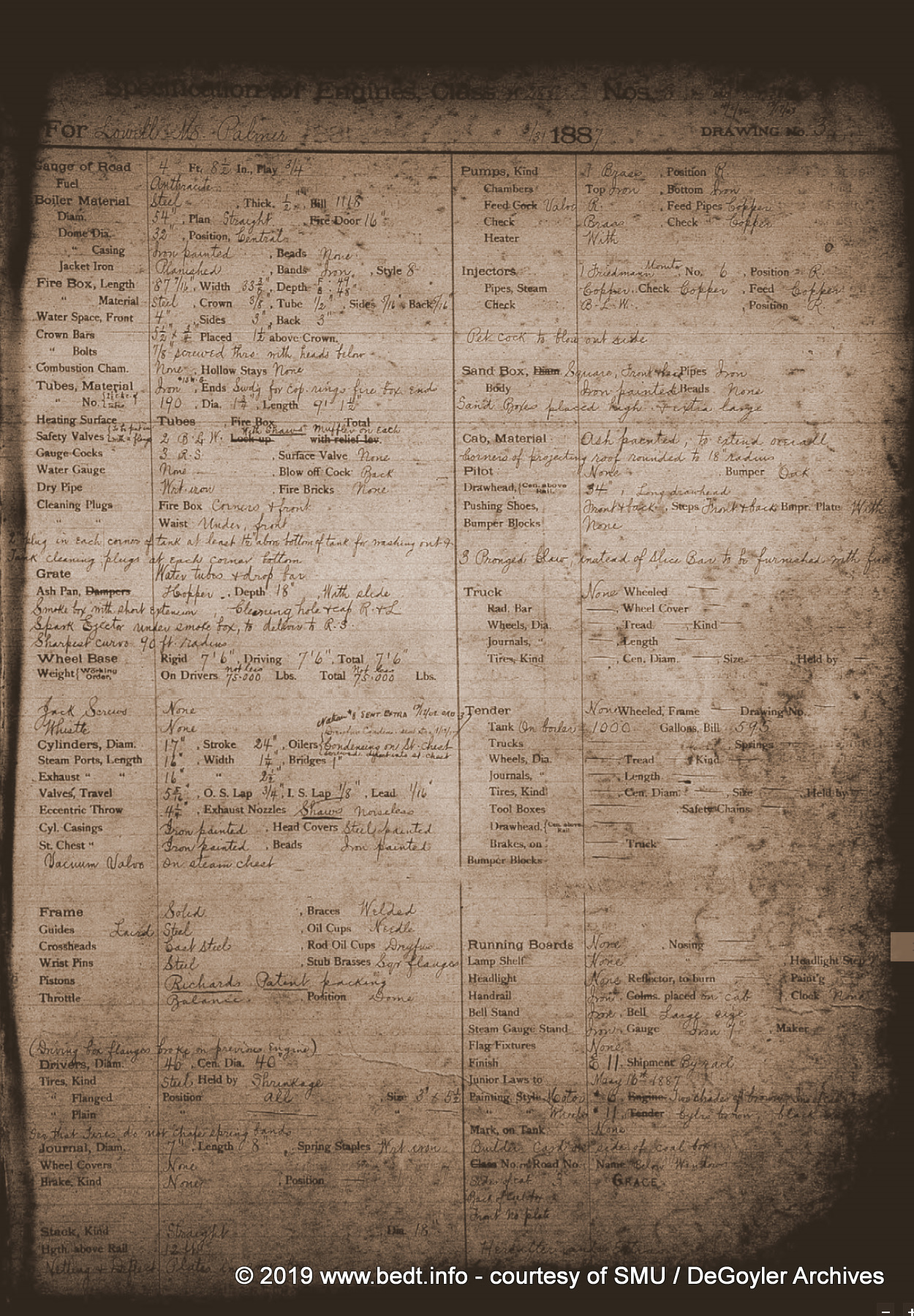 #3 "Grace" |
| . . |
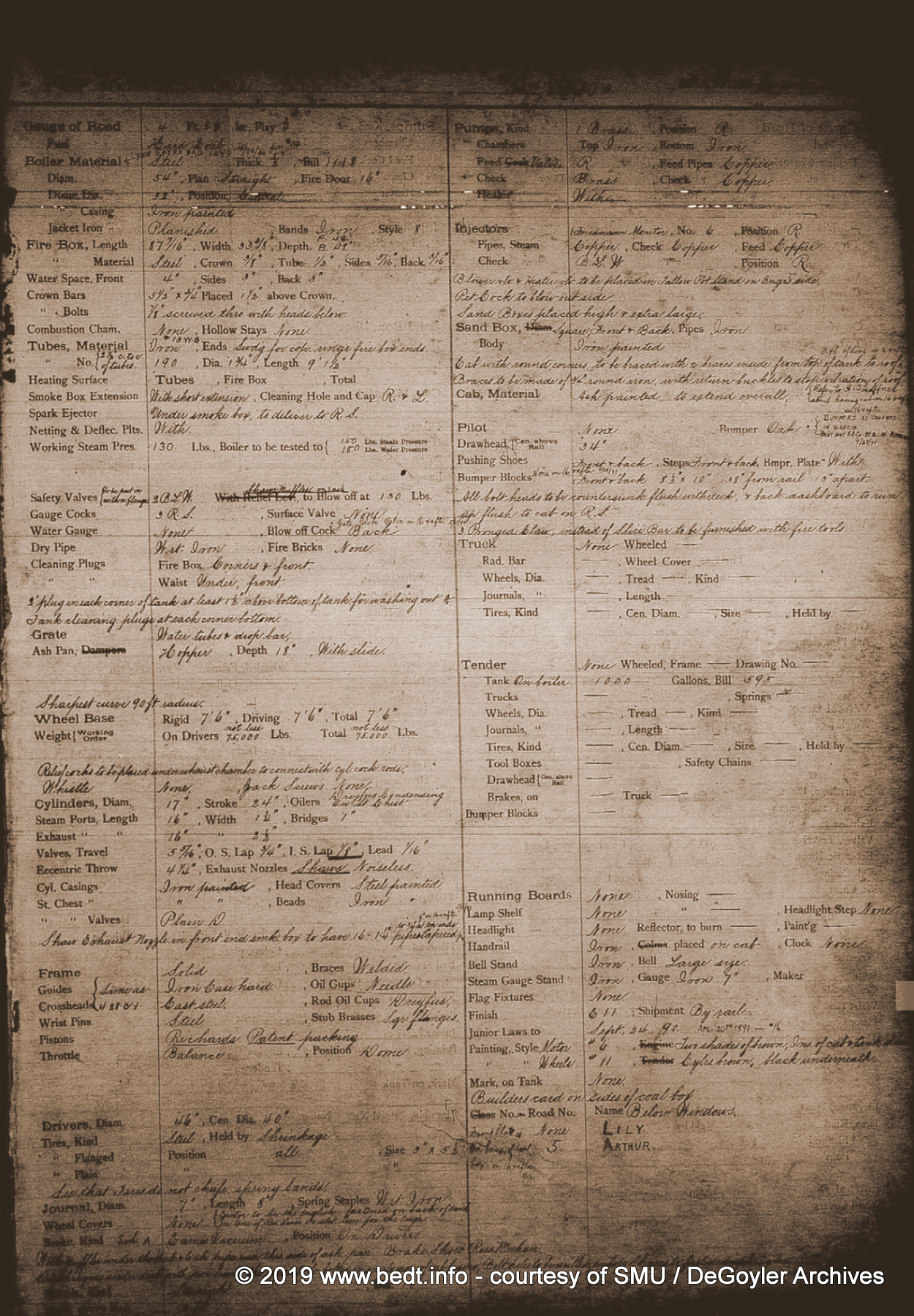 #4 "Lily" and #5 "Arthur" |
| . . |
 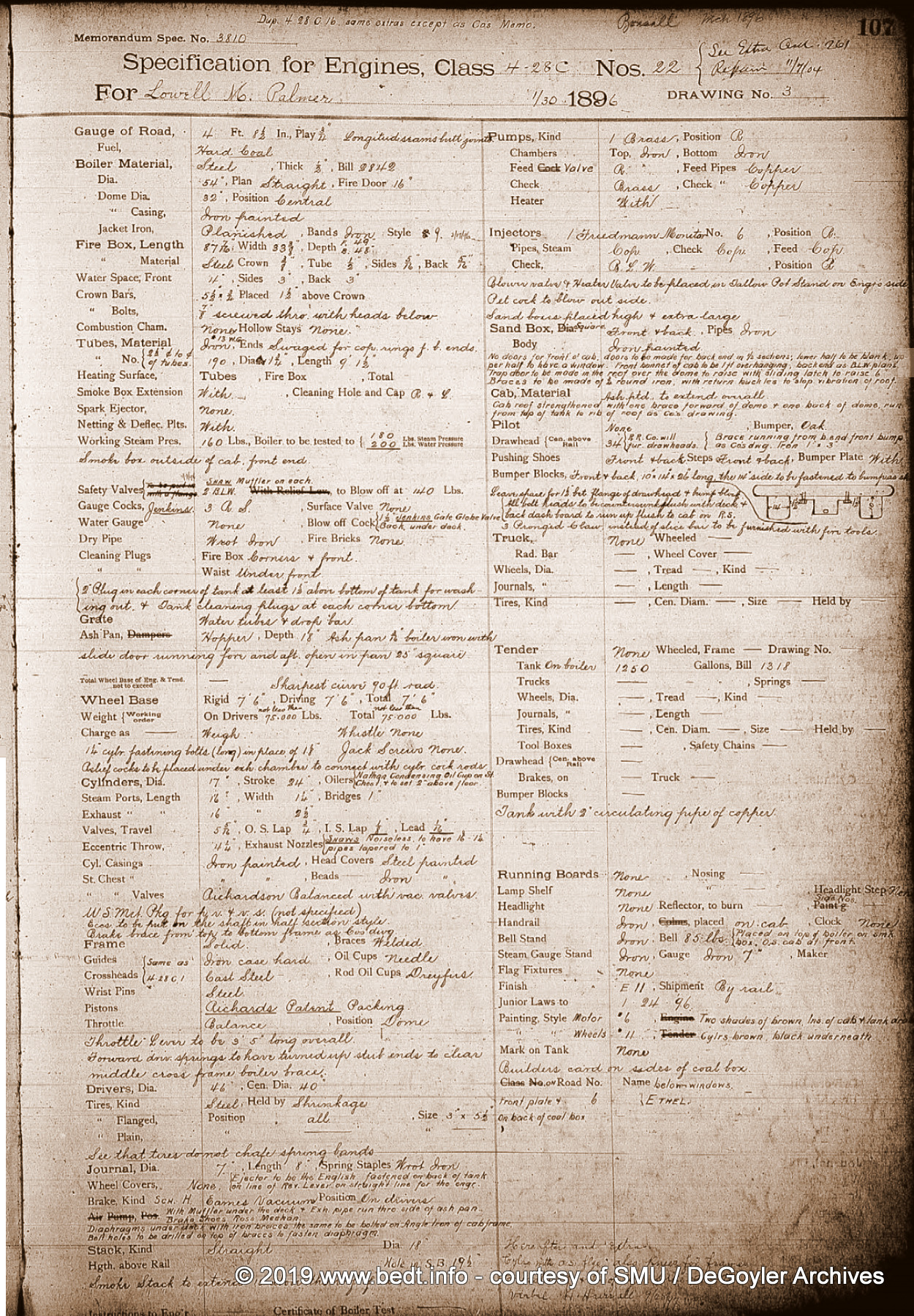 #6 "Ethel" |
| . . |
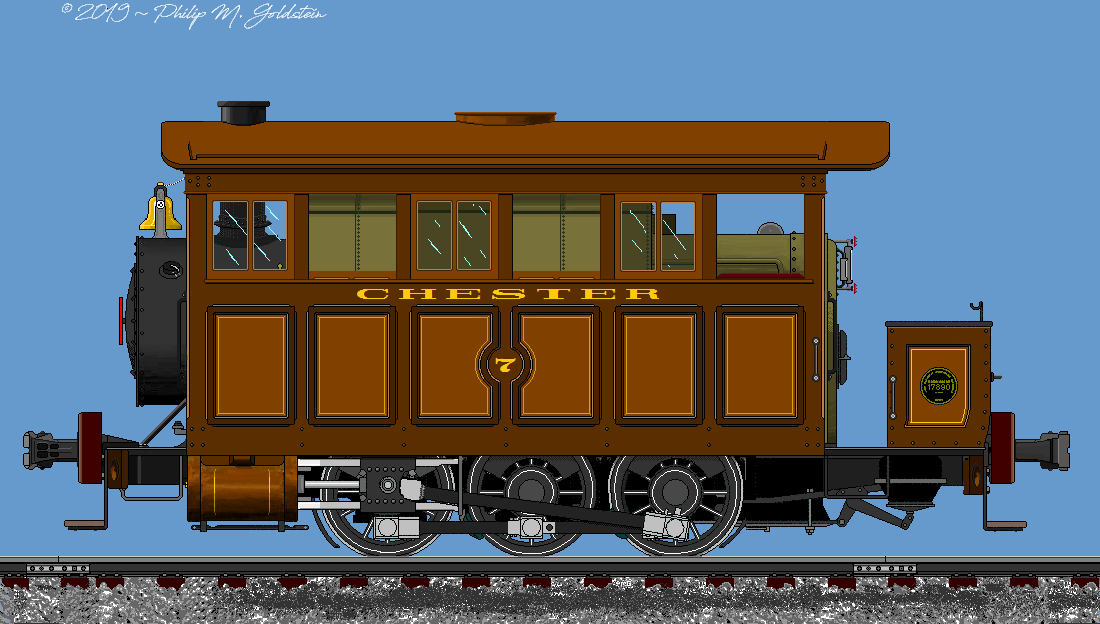 . 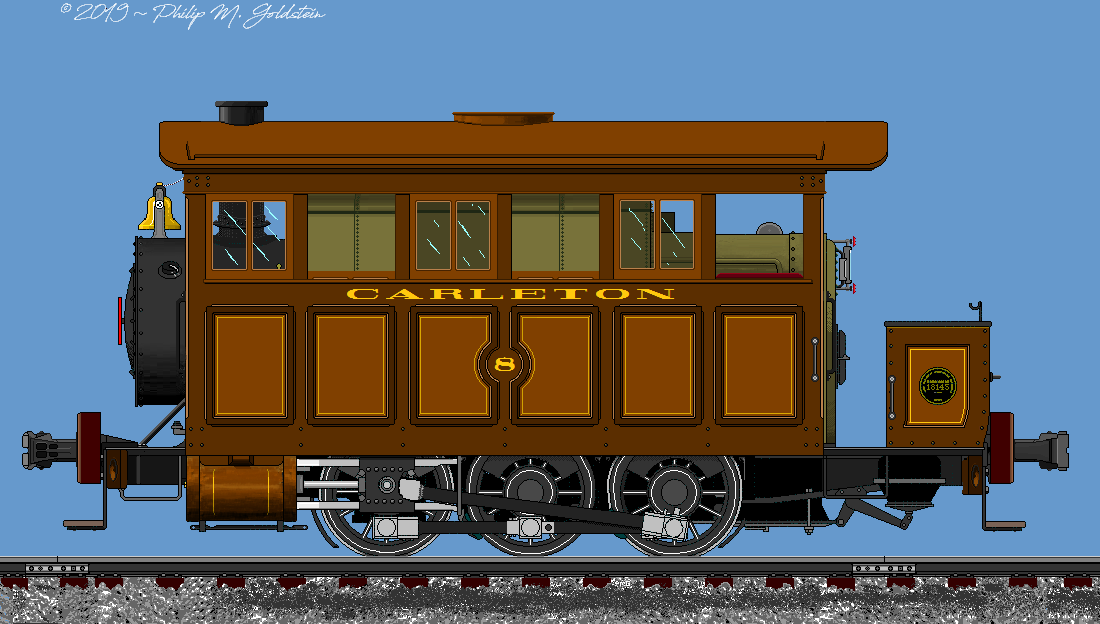 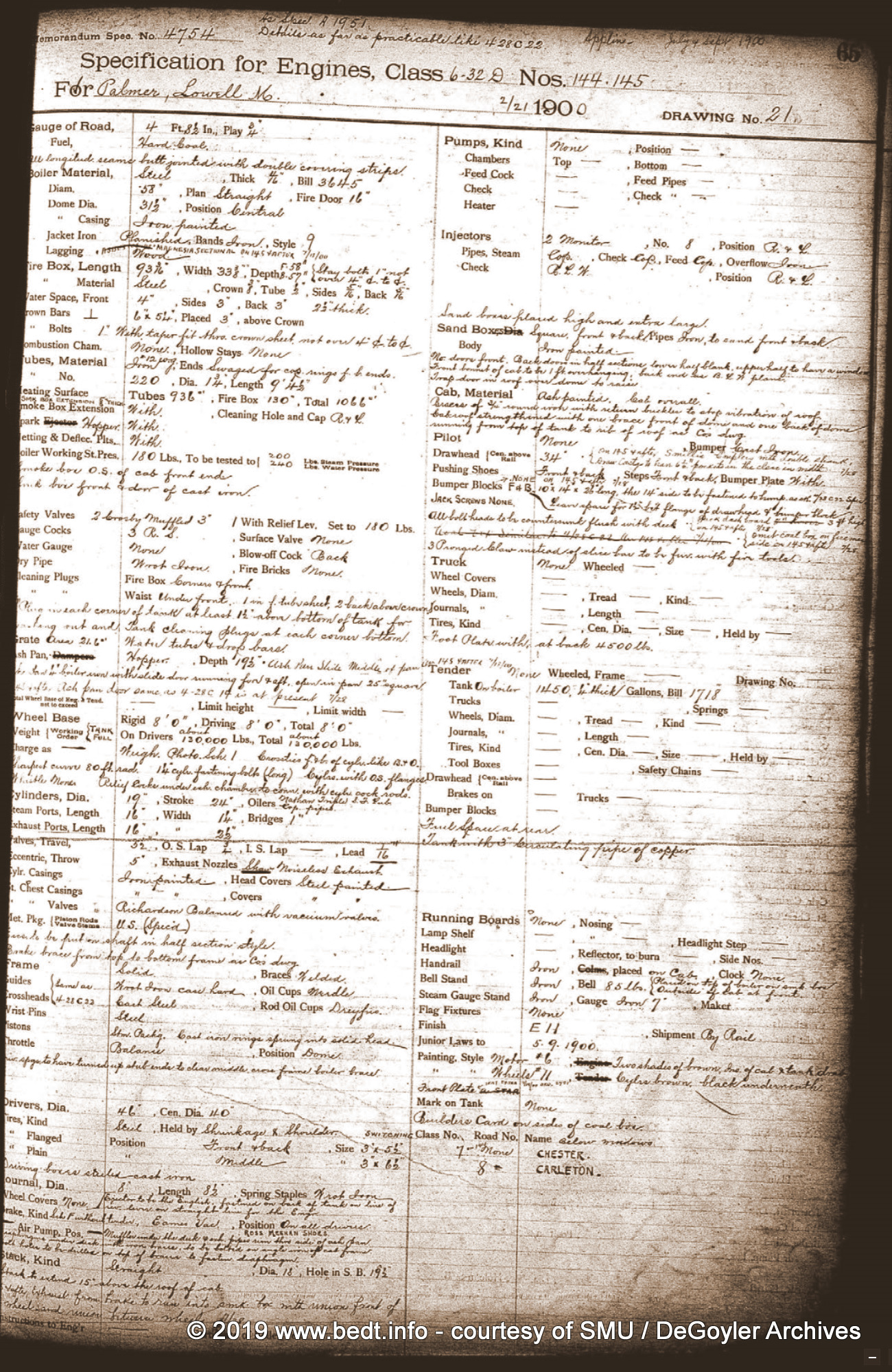 #7 "Chester" and #8 "Carleton" |
| . . |
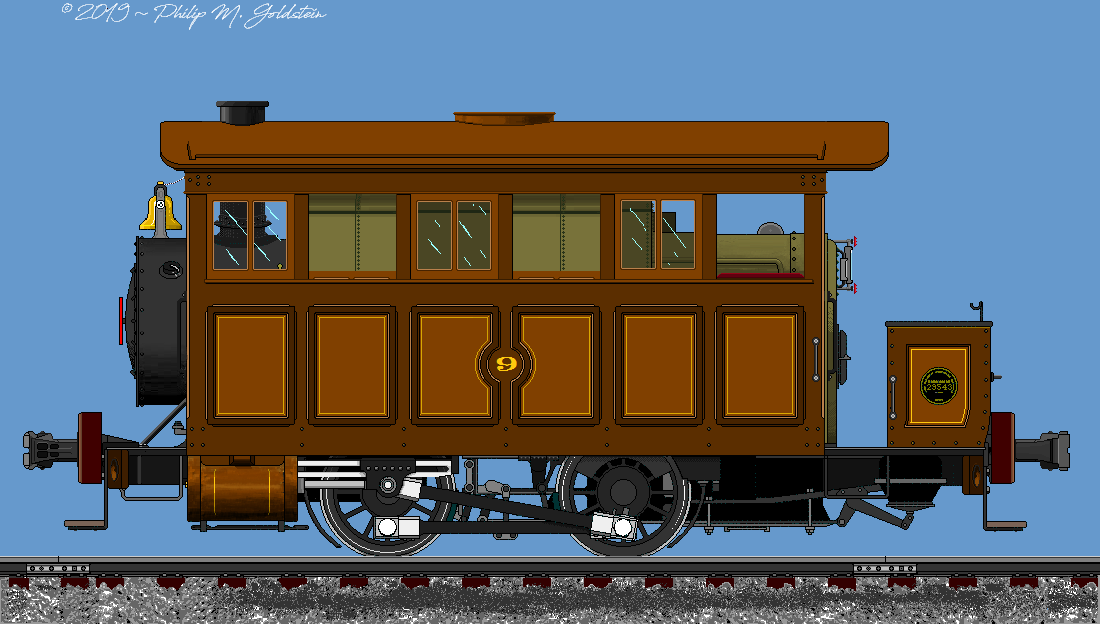 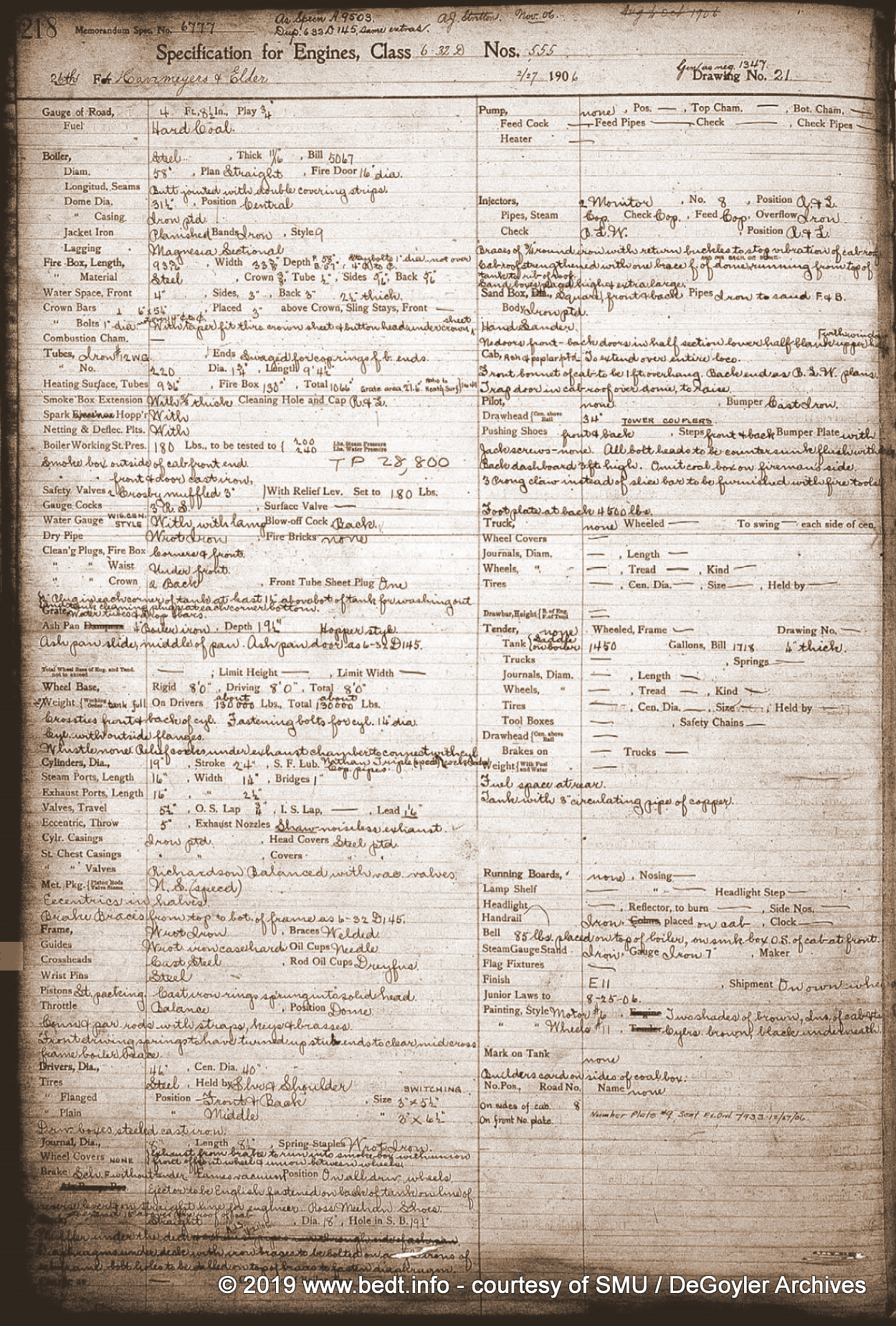 #9 |
| . . |
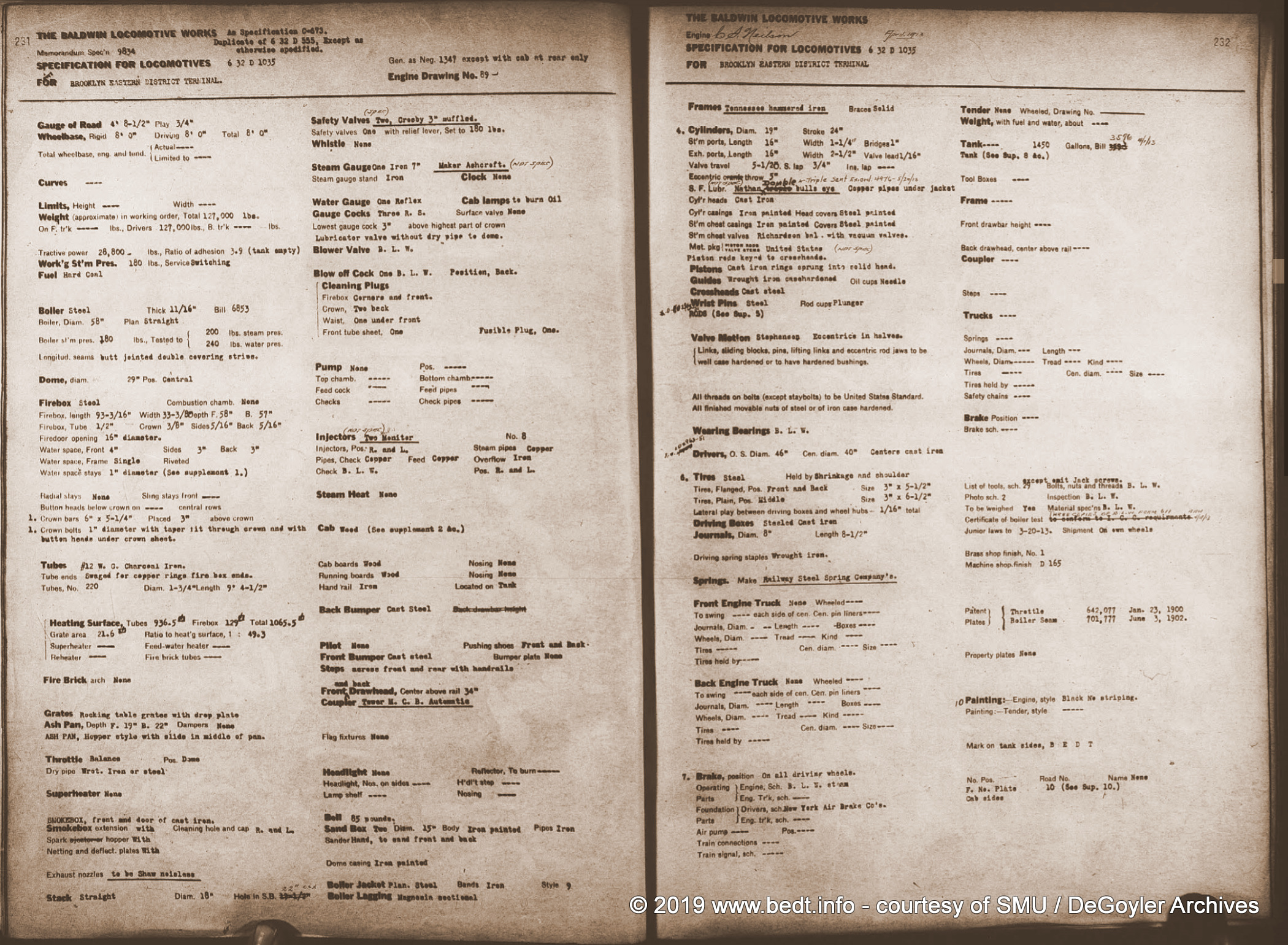 |
 #10 |
| . . |
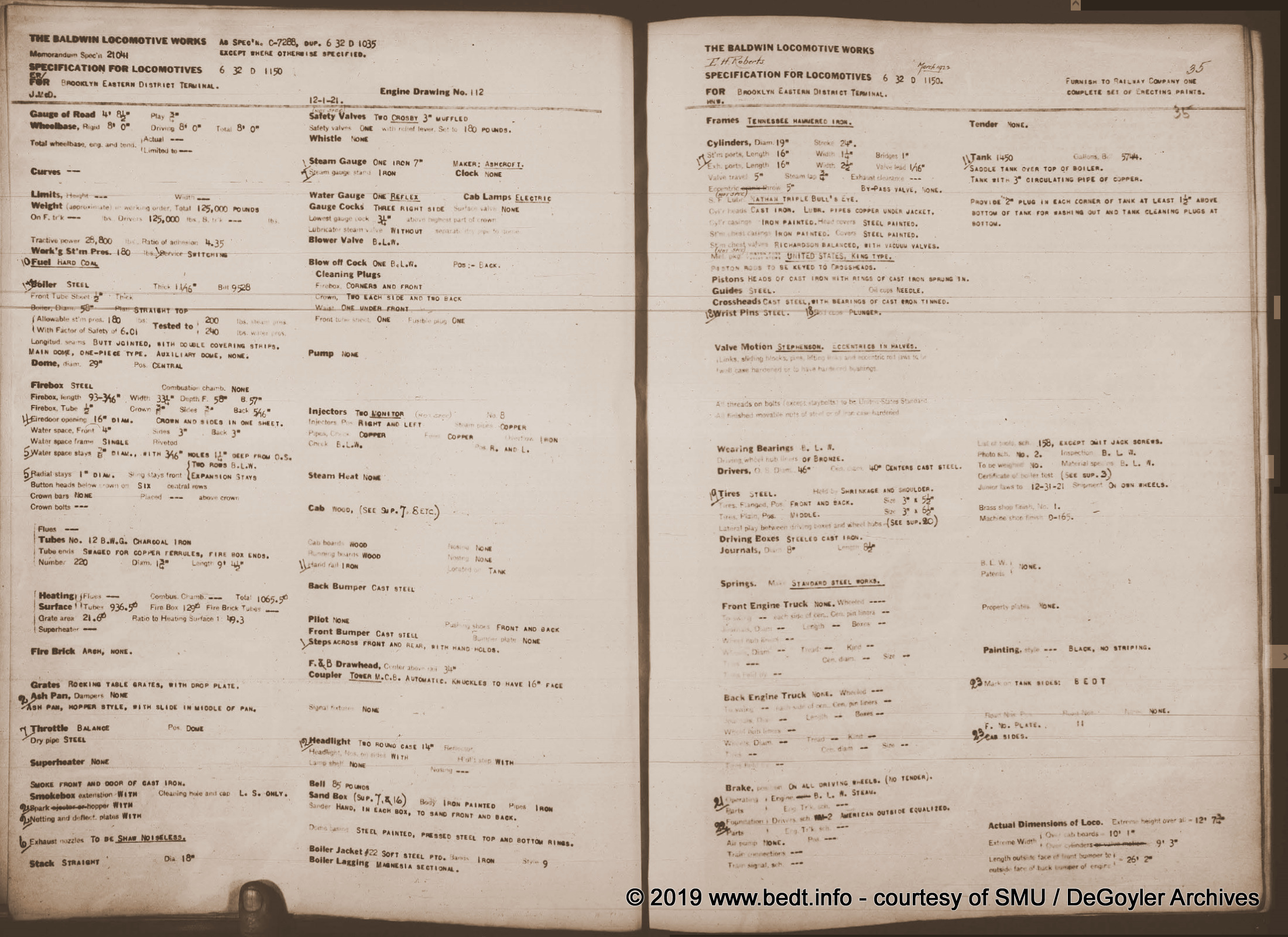 |
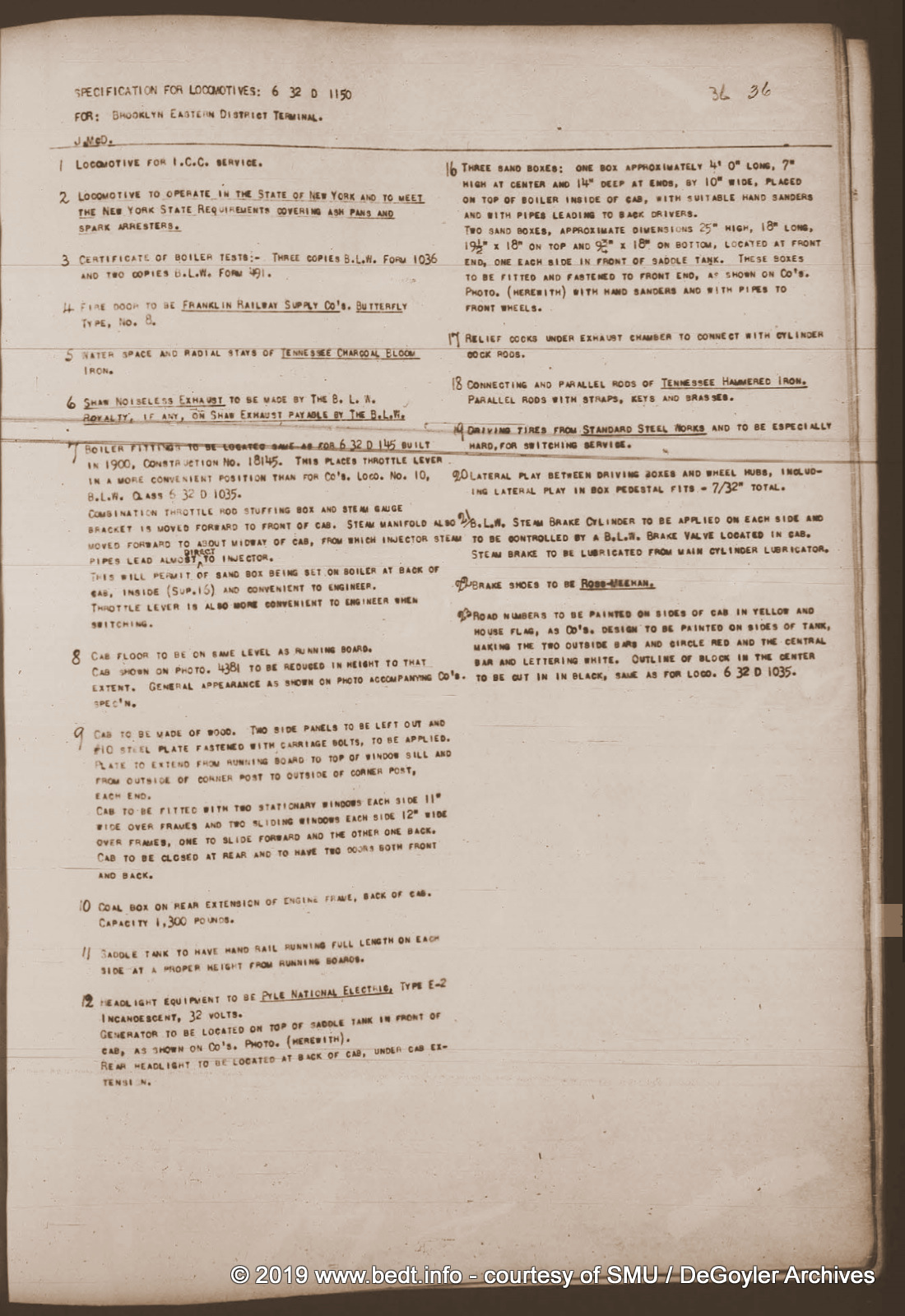 #11 |
B.E.D.T.
Steam Locomotive Movies
In this chapter, there are now two films
(converted to digital format) of the Brooklyn Eastern District Terminal in
action!
The first video was originally 16mm with no sound, and taken
by Bob Hart on July 2, 1957. I met Mr. Hart at the Clark, NJ "Mother Seton
H.S." Train Show on 06 March 2011, and he informed me he had this footage.
Mr. Hart mailed me the DVD and I received it 15 March 2011. In this video,
we have #11 and #16 in operation.
The second video clip which was originally 8mm and no sound;
was acquired by me back in 2006. It was taken by Gerald Landau, and I acquired
it from Norm & Marie Wright. Unfortunately, the date that the original
film was "shot" is not known. Upon viewing the video however, #10 is still
in service and #11 is already out of service and being cannibalized. This
would place the date of the video after September 1958 (when #11 was taken
out of service) and before October 1962 (when #10 was taken out of
service).
This video shows #10 and #12 in operation with #11 out of service.
 |
.... | 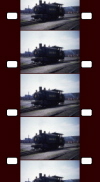 |
July 2, 1957 |
ca. 1958-1962 |
Palmer's Dock / East River Terminal / Brooklyn
Eastern District Terminal
Steam Locomotive
Roster
Specifications, Locations & Owner Information,
Condition & Restoration Reports
| Click on number plates below the data to view images of that locomotive! |
I have yet to find ANY photographs of the Frederick C. Havemeyer, or
#2 through 5 anywhere in either Palmer's Dock, East River Terminal or Brooklyn Eastern District Terminal
livery.
If you have a picture or image of the Frederick Havemeyer, or numbers 2,
3, 4 or 5 that you can share or any picture of ERT / BEDT locomotives,
I'll be pleased to place on this website with all due credit & provenance.
Thank You!
|
|||||||||||||||||||||||||||||||||||||||||||||||||||||||||||||||||||||||||||||||||
|
|||||||||||||||||||||||||||||||||||||||||||||||||||||||||||||||||||||||||||||||||
| Owner History: | Havemeyer & Elder "Frederick C. Havemeyer" (no number) ERT ? Brooklyn Eastern District Terminal |
||||||||||||||||||||||||||||||||||||||||||||||||||||||||||||||||||||||||||||||||
| Present Location: | scrapped unknown date | ||||||||||||||||||||||||||||||||||||||||||||||||||||||||||||||||||||||||||||||||
| Notes: |
built as 6' gauge, regauged for Palmer's Dock by BLW. built as steam dummy on BEDT property in 1927, retired prior to 1933 |
||||||||||||||||||||||||||||||||||||||||||||||||||||||||||||||||||||||||||||||||
SORRY,
.
|
|||||||||||||||||||||||||||||||||||||||||||||||||||||||||||||||||||||||||||||||||
.
.
|
|||||||||||||||||||||||||||||||||||||||||||||||||||||||||||||||||||||||||||||||||
|
|||||||||||||||||||||||||||||||||||||||||||||||||||||||||||||||||||||||||||||||||
| Owner History: | Lowell M. Palmer #2 Brooklyn Eastern District Terminal #2 |
||||||||||||||||||||||||||||||||||||||||||||||||||||||||||||||||||||||||||||||||
| Present Location: | scrapped unknown date | ||||||||||||||||||||||||||||||||||||||||||||||||||||||||||||||||||||||||||||||||
| Notes: |
built as Steam Dummy on BEDT property in 1927, retired prior to 1933 |
||||||||||||||||||||||||||||||||||||||||||||||||||||||||||||||||||||||||||||||||
SORRY,
.
|
|||||||||||||||||||||||||||||||||||||||||||||||||||||||||||||||||||||||||||||||||
.
.
|
|||||||||||||||||||||||||||||||||||||||||||||||||||||||||||||||||||||||||||||||||
|
|||||||||||||||||||||||||||||||||||||||||||||||||||||||||||||||||||||||||||||||||
| Owner History: | Lowell M. Palmer #3 Brooklyn Eastern District Terminal #3 |
||||||||||||||||||||||||||||||||||||||||||||||||||||||||||||||||||||||||||||||||
| Present Location: | scrapped unknown date | ||||||||||||||||||||||||||||||||||||||||||||||||||||||||||||||||||||||||||||||||
| Notes: |
built as Steam Dummy on BEDT property in 1927, retired prior to 1933 |
||||||||||||||||||||||||||||||||||||||||||||||||||||||||||||||||||||||||||||||||
SORRY,
.
|
|||||||||||||||||||||||||||||||||||||||||||||||||||||||||||||||||||||||||||||||||
.
.
|
|||||||||||||||||||||||||||||||||||||||||||||||||||||||||||||||||||||||||||||||||
|
|||||||||||||||||||||||||||||||||||||||||||||||||||||||||||||||||||||||||||||||||
| Owner History: | Lowell M. Palmer #4 Brooklyn Eastern District Terminal #4 |
||||||||||||||||||||||||||||||||||||||||||||||||||||||||||||||||||||||||||||||||
| Present Location: | scrapped unknown date | ||||||||||||||||||||||||||||||||||||||||||||||||||||||||||||||||||||||||||||||||
| Notes: |
built as steam dummy on BEDT property in 1927, retired prior to 1933 |
||||||||||||||||||||||||||||||||||||||||||||||||||||||||||||||||||||||||||||||||
SORRY,
.
|
|||||||||||||||||||||||||||||||||||||||||||||||||||||||||||||||||||||||||||||||||
.
.
.
.
|
|||||||||||||||||||||||||||||||||||||||||||||||||||||||||||||||||||||||||||||||||
|
|||||||||||||||||||||||||||||||||||||||||||||||||||||||||||||||||||||||||||||||||
| Owner History: | Lowell M. Palmer #6 Brooklyn Eastern District Terminal #6 |
||||||||||||||||||||||||||||||||||||||||||||||||||||||||||||||||||||||||||||||||
| Present Location: | scrapped unknown date | ||||||||||||||||||||||||||||||||||||||||||||||||||||||||||||||||||||||||||||||||
| Notes: |
built as a steam dummy, rebuilt 1918 as a low style 3/4 saddletank on BEDT property as of September 1933 retired between 1933 and 1936 |
||||||||||||||||||||||||||||||||||||||||||||||||||||||||||||||||||||||||||||||||
.
|
|||||||||||||||||||||||||||||||||||||||||||||||||||||||||||||||||||||||||||||||||
|
|||||||||||||||||||||||||||||||||||||||||||||||||||||||||||||||||||||||||||||||||
|
|||||||||||||||||||||||||||||||||||||||||||||||||||||||||||||||||||||||||||||||||
| Owner History: | Lowell M. Palmer #7 Brooklyn Eastern District Terminal #7 |
||||||||||||||||||||||||||||||||||||||||||||||||||||||||||||||||||||||||||||||||
| Present Location: | scrapped unknown date | ||||||||||||||||||||||||||||||||||||||||||||||||||||||||||||||||||||||||||||||||
| Notes: |
built as steam dummy in service as of January 1947 rebuilt as square sided saddletank |
||||||||||||||||||||||||||||||||||||||||||||||||||||||||||||||||||||||||||||||||
.
|
|||||||||||||||||||||||||||||||||||||||||||||||||||||||||||||||||||||||||||||||||
.
.
|
|||||||||||||||||||||||||||||||||||||||||||||||||||||||||||||||||||||||||||||||||
|
|||||||||||||||||||||||||||||||||||||||||||||||||||||||||||||||||||||||||||||||||
| Owner History: | Lowell M. Palmer #8 Brooklyn Eastern District Terminal #8 |
||||||||||||||||||||||||||||||||||||||||||||||||||||||||||||||||||||||||||||||||
| Present Location: | scrapped unknown date | ||||||||||||||||||||||||||||||||||||||||||||||||||||||||||||||||||||||||||||||||
| Notes: |
built as steam dummy on BEDT property as late as September 1933 retired between 1933 and 1936 unknown if rebuilt; if so, most likely had same "low style" 3/4 saddletank as #6 |
||||||||||||||||||||||||||||||||||||||||||||||||||||||||||||||||||||||||||||||||
.
|
|||||||||||||||||||||||||||||||||||||||||||||||||||||||||||||||||||||||||||||||||
.
.
|
|||||||||||||||||||||||||||||||||||||||||||||||||||||||||||||||||||||||||||||||||
|
|||||||||||||||||||||||||||||||||||||||||||||||||||||||||||||||||||||||||||||||||
| Owner History: | Havemeyer & Elder #9 Brooklyn Eastern District Terminal #9 |
||||||||||||||||||||||||||||||||||||||||||||||||||||||||||||||||||||||||||||||||
| Present Location: | scrapped unknown date | ||||||||||||||||||||||||||||||||||||||||||||||||||||||||||||||||||||||||||||||||
| Notes: |
built as steam dummy in service as late as October 1934 retired between 1934 and 1936 built as round saddletank? converted to square sided saddletank by BEDT |
||||||||||||||||||||||||||||||||||||||||||||||||||||||||||||||||||||||||||||||||
.
.
|
|||||||||||||||||||||||||||||||||||||||||||||||||||||||||||||||||||||||||||||||||
.
.
|
|||||||||||||||||||||||||||||||||||||||||||||||||||||||||||||||||||||||||||||||||
|
|||||||||||||||||||||||||||||||||||||||||||||||||||||||||||||||||||||||||||||||||
| Owner History: | Brooklyn Eastern District Terminal #10 | ||||||||||||||||||||||||||||||||||||||||||||||||||||||||||||||||||||||||||||||||
| Present Location: | scrapped April - July 1963 | ||||||||||||||||||||||||||||||||||||||||||||||||||||||||||||||||||||||||||||||||
| Notes: |
built as round saddletank, closed cab (see steam loco notes) converted to square sided saddletank by BEDT |
||||||||||||||||||||||||||||||||||||||||||||||||||||||||||||||||||||||||||||||||
.
.
|
|||||||||||||||||||||||||||||||||||||||||||||||||||||||||||||||||||||||||||||||||
.
.
|
|||||||||||||||||||||||||||||||||||||||||||||||||||||||||||||||||||||||||||||||||
|
|||||||||||||||||||||||||||||||||||||||||||||||||||||||||||||||||||||||||||||||||
| Owner History: | Brooklyn Eastern District Terminal #11 | ||||||||||||||||||||||||||||||||||||||||||||||||||||||||||||||||||||||||||||||||
| Condition: | scrapped BEDT July 1962 | ||||||||||||||||||||||||||||||||||||||||||||||||||||||||||||||||||||||||||||||||
| Notes: | built as round saddletank, open cab (see steam loco notes) converted to square sided saddletank by BEDT |
||||||||||||||||||||||||||||||||||||||||||||||||||||||||||||||||||||||||||||||||
.
.
|
|||||||||||||||||||||||||||||||||||||||||||||||||||||||||||||||||||||||||||||||||
.
.
|
|||||||||||||||||||||||||||||||||||||||||||||||||||||||||||||||||||||||||||||||||||||||||||||||||||||
|
|||||||||||||||||||||||||||||||||||||||||||||||||||||||||||||||||||||||||||||||||||||||||||||||||||||
| Owner History: | 3/1919 - 1922: US Navy Fleet Supply Base - South
Brooklyn Section #3 (Brooklyn, NY) 1922 - 6/1963: BEDT #12 (Brooklyn, NY) 6/1963 - 3/1971: Ron Ziel (New York, NY) 3/1971 - ? : Robert Most (Tampa, FL) |
||||||||||||||||||||||||||||||||||||||||||||||||||||||||||||||||||||||||||||||||||||||||||||||||||||
| Present Location: | Florida Rail Road Museum, Parrish, FL | ||||||||||||||||||||||||||||||||||||||||||||||||||||||||||||||||||||||||||||||||||||||||||||||||||||
| Condition: | painted and lettered in BEDT! (5/2010) non-running display |
||||||||||||||||||||||||||||||||||||||||||||||||||||||||||||||||||||||||||||||||||||||||||||||||||||
| Notes: | H. K. Porter "Heavy" side-tank model
Builders identical twin to #13 and US Navy Fleet Supply Base -
South Brooklyn Section Ron Ziel confirms he purchased #12 in June 1963 for the sum of $900.
Popularly (but erroneously) believed to have been a Brooklyn Navy Yard
locomotive. |
||||||||||||||||||||||||||||||||||||||||||||||||||||||||||||||||||||||||||||||||||||||||||||||||||||
.
.
|
|||||||||||||||||||||||||||||||||||||||||||||||||||||||||||||||||||||||||||||||||||||||||||||||||||||
.
.
|
|||||||||||||||||||||||||||||||||||||||||||||||||||||||||||||||||||||||||||||||||||||||||||||||||||||
|
|||||||||||||||||||||||||||||||||||||||||||||||||||||||||||||||||||||||||||||||||||||||||||||||||||||
| Owner History: | 3/1919 - 1922: US
Navy Fleet Supply Base - South Brooklyn Section #4 (Brooklyn,
NY) 1922 - 1963: BEDT #13 (Brooklyn, NY) 10/1963 - 1/1977: Rail Tours Inc. (York, PA) 1/1977 - 12/15/2011: Railroad Museum of Pennsylvania (Strasburg, PA) |
||||||||||||||||||||||||||||||||||||||||||||||||||||||||||||||||||||||||||||||||||||||||||||||||||||
| Present Location: | Age Of Steam Roundhouse, (J. Jacobsen), Sugarcreek, OH | ||||||||||||||||||||||||||||||||||||||||||||||||||||||||||||||||||||||||||||||||||||||||||||||||||||
| Condition: | painted, unlettered, non-running display - possible return to operation as yard goat | ||||||||||||||||||||||||||||||||||||||||||||||||||||||||||||||||||||||||||||||||||||||||||||||||||||
| Notes: | H. K. Porter "Heavy" side-tank model Builders identical twin to #12 and US Navy Fleet Supply Base - South Brooklyn Section #1 (c/n 6366) & #2 (c/n 6367) (all have consecutive SN's) BEDT documents dated June 24, 1963 request $2,500 asking price of #13. Non-BEDT documents show #13 was sold to G. Hart. Moved to Reading, PA; 1968
One of the driver tires from No. 13 now serves as a fire bell hanger at
the front entrance
Popularly (but erroneously) believed to have been a Brooklyn Navy Yard
locomotive. |
||||||||||||||||||||||||||||||||||||||||||||||||||||||||||||||||||||||||||||||||||||||||||||||||||||
.
.
|
|||||||||||||||||||||||||||||||||||||||||||||||||||||||||||||||||||||||||||||||||||||||||||||||||||||
.
.
|
|||||||||||||||||||||||||||||||||||||||||||||||||||||||||||||||||||||||||||||||||||||||||||||||||||||
|
|||||||||||||||||||||||||||||||||||||||||||||||||||||||||||||||||||||||||||||||||||||||||||||||||||||
| Owner History: | 8/1920 - 1935: Mesta Machine Works #5
(West Homestead, PA) 1935 - 1935: Birmingham Rail & Locomotive Co. (Birmingham, AL) (supplier & broker) 2/18/1935 - 1963: BEDT #14 (Brooklyn, NY) 1964 - 1965: Maryland & Pennsylvania #14 [Railtours] (York, PA) 1965 - 1993: Black River & Western #14 (Ringoes, NJ) |
||||||||||||||||||||||||||||||||||||||||||||||||||||||||||||||||||||||||||||||||||||||||||||||||||||
| Present Location: | Ulster & Delaware RR Historical Society, (Arkville, NY) | ||||||||||||||||||||||||||||||||||||||||||||||||||||||||||||||||||||||||||||||||||||||||||||||||||||
| Condition: | under cosmetic restoration, restoration to operation pending funding. |
||||||||||||||||||||||||||||||||||||||||||||||||||||||||||||||||||||||||||||||||||||||||||||||||||||
| Notes: | H. K. Porter "Medium" saddle-tank model ("3/4 length" saddletank)
Suffered firebox explosion in 1953 (see loco footnotes) |
||||||||||||||||||||||||||||||||||||||||||||||||||||||||||||||||||||||||||||||||||||||||||||||||||||
.
.
|
|||||||||||||||||||||||||||||||||||||||||||||||||||||||||||||||||||||||||||||||||||||||||||||||||||||
.
.
|
|||||||||||||||||||||||||||||||||||||||||||||||||||||||||||||||||||||||||||||||||||||||||||||||||||||
|
|||||||||||||||||||||||||||||||||||||||||||||||||||||||||||||||||||||||||||||||||||||||||||||||||||||
| Owner History: | 3/1917 - ? : Mesta Machine Works
(West Homestead, PA) (number unknown -
most likely #4) ? - 1965: BEDT #15 (Brooklyn, NY) 1965 - 1975: South Appalachia Rwy #15 (Burnsville, NC) 1975 - 1998: Toledo, Lake Erie & Western #15 (Grand Rapids, OH) |
||||||||||||||||||||||||||||||||||||||||||||||||||||||||||||||||||||||||||||||||||||||||||||||||||||
| Present Location: | Thomas the Tank Engine #1 (operational), Strasburg RR (Strasburg, PA) | ||||||||||||||||||||||||||||||||||||||||||||||||||||||||||||||||||||||||||||||||||||||||||||||||||||
| Condition: | only BEDT loco currently under steam. #15 was completely stripped,
rebuilt, converted to coal firing and side tank, and cosmetically altered to resemble Thomas the Tank Engine. |
||||||||||||||||||||||||||||||||||||||||||||||||||||||||||||||||||||||||||||||||||||||||||||||||||||
| Notes: | H. K. Porter "Medium" saddle-tank model ("3/4 length" saddletank) Oldest of the surviving BEDT locos, Rounded bottom of saddletank repaired / modified with square "skirt" (out of service March 8, 1962 - May 31, 1962)
BEDT documents dated June 24, 1963 request $5,000 asking price of #15. Sold 1975 to Toledo, Lake Erie & Western, in Ohio.
Sold by Keith Brigode in 3/1998 to Strasburg Railroad Corp.; |
||||||||||||||||||||||||||||||||||||||||||||||||||||||||||||||||||||||||||||||||||||||||||||||||||||
|
|||||||||||||||||||||||||||||||||||||||||||||||||||||||||||||||||||||||||||||||||||||||||||||||||||||
.
.
|
|||||||||||||||||||||||||||||||||||||||||||||||||||||||||||||||||||||||||||||||||||||||||||||||||||||
.
.
|
|||||||||||||||||||||||||||||||||||||||||||||||||||||||||||||||||||||||||||||||||||||||||||||||||||||
|
|||||||||||||||||||||||||||||||||||||||||||||||||||||||||||||||||||||||||||||||||||||||||||||||||||||
| Owner History: | 1/1923 - ? :
Astoria Light, Heat & Power #5, (Queens, NY) ? - ? : Fleischmanns Transportation, (Peekskill, NY) (number unknown) ? - 1939: Birmingham Rail & Locomotive Co. (Birmingham, AL) (supplier & broker) 1//13/1939 - 1963: BEDT #16 (Brooklyn, NY) (operational until 1963) 1963 - 1983: George Foster - stored on BEDT property (Brooklyn, NY) 1983 - 1993: abandoned in place, former BEDT property 1993 - 1/1999: moved & stored at NY Cross Harbor enginehouse Bush Terminal (Brooklyn, NY) |
||||||||||||||||||||||||||||||||||||||||||||||||||||||||||||||||||||||||||||||||||||||||||||||||||||
| Present Location: | Railroad Museum of Long Island, Riverhead, NY | ||||||||||||||||||||||||||||||||||||||||||||||||||||||||||||||||||||||||||||||||||||||||||||||||||||
| Condition: | non-running display; running gear removed, missing mainrods. 2010
plans are to reassemble loco. anticipated cosmetic restoration, |
||||||||||||||||||||||||||||||||||||||||||||||||||||||||||||||||||||||||||||||||||||||||||||||||||||
| Notes: | H. K. Porter "Heavy" saddle-tank model ("full length" saddletank - one of a kind on BEDT) Youngest of the surviving BEDT locos,
Rounded bottom of saddletank repaired / modified with square "skirt" between
6/1959 & 10/1960
In actuality, #16 had been sold to George Foster, for use
in conjunction with BEDT #12 &
According to sources at the Trolley Museum of New York
in Kingston, they were supposed to
New information states #16 was NOT brought to Riverhead in error, but
was sent there intentionally with |
||||||||||||||||||||||||||||||||||||||||||||||||||||||||||||||||||||||||||||||||||||||||||||||||||||
.
.
|
|||||||||||||||||||||||||||||||||||||||||||||||||||||||||||||||||||||||||||||||||||||||||||||||||||||
| Numbering / Age | New vs. Preowned | Fuels & Conversions | Cab Styles |
| Wheel Arrangement | Driver Diameters | Flanges | Switch De-icers |
| Couplers | Brakes | Footboards | Saddletank Repairs / Styles |
| #14 Lettering | #14 Firebox Explosion | Locomotive Collision? |
.
.
Baldwin built #8 was built before and is chronologically older that #7, even though it was assigned a higher road number. This can possibly be explained as #7 and #8 were ordered on the same specification sheet.
H. K. Porter construction numbers and dates are out
of sequence for #12, 13 and 14:
#12 and #13 were both built 3/1919 and are numbered 6368 and 6369 respectively.
#14 was built over a year later in 8/1920; yet has a lower construction
number of 6260.
This data is accurate upon referencing H. K. Porter build records.
H. K. Porter built numbers 12, 13, 14, 15 are chronologically older the Baldwin built number 11.
.
.
New vs. Pre-Owned Locomotive
Purchases
Baldwin built locomotives, "Frederick C. Havemeyer" through number 11, were purchased new.
H. K. Porter built locomotives, numbers 12 through 16, were purchased pre-owned.
All new locomotives purchased were owned by either Lowell M. Palmer or the Havemeyer & Elder Co. Inc, (parent company) and were leased to the East River Terminal Railroad or Brooklyn Eastern District Terminal for exclusive operation.
.
.
A document from George Hart dated 1967, states that he understands that #14 was converted to oil from coal in 1935 or 1936 (about the time BEDT acquired the locomotives). No other documentation exists regarding these conversions nor has any resemblance or remnants of an ash pan been seen on 14. However, the firebox bottom currently in place is of welded construction, and not cast steel like the surrounding flange or other fixtures under the locomotive. This firebox bottom is attached to the frame with a number of bolts around the perimeter of the firebox and appears to be removable.
The builders picture of #16 (as Astoria Light, Heat and Power #5) shows a tapered style coal bunker as well. Considering Astoria Light, Heat & Power utilized coal for their gasification plants, it only seem logical the locomotive was fired by coal as well when operated by them.
.
.
Baldwin built locos "Frederick C. Havemeyer" through #9
were built as "steam dummy'
locomotives, also known as "cab all over". Baldwin built #10 and #11 were built from the start as conventional locomotives,
as were all the H.K. Porter locomotives.
.
Baldwin
built locomotives #6 through 9 and #11 were rebuilt with steel
"European" style cabs with doors across the back, but #10 was built
with an enclosed wood cab with doors on the side; which BEDT converted
to a steel cab to match #11.
H. K. Porter built #12 through 16 were built with enclosed
steel cabs with doors on the sides of the cab.
Also, the 1914 photo clearly shows a non steam dummy
locomotive in the yard. It is unknown if the dummy shell was removed from
some or all of the locomotives by that time.
.
.
.
.
.
Only the Frederick C. Havemeyer had 45" drivers. All other Baldwin built locomotives were specified for 46" drivers.
Many published and internet documents
state that H. K. Porter built locomotives #12 through 16 had 40" drivers.
The H.K. Porter catalog calls for 46" drivers for this model locomotive with
this corresponding cylinder size, boiler pressure and traction effort
combinations.
BEDT maintenance records for BEDT steam locomotives prior to 1963
show 46" diameter, but the BEDT steam locomotive sales prospectus dated
1963 has that 40" measurement.
Current measurements of #13,
#14 and #16 show 44.5" (allowance for wear), 46" and 46" respectively.
The
source of this confusion may arise from the wheel specifications, which
denote 40" wheel, 46" tire. This can be viewed in the Baldwin
Specification Sheets. But, as one can see, even as far back as the
construction of #2, wheels were specified as 46", and remained so
through all locomotives. Recent (May 2019) acquistion of the blueprints
for H. K. Porter c/n 6368, 6369 (BEDT #12 & #13), 5966 (BEDT
#15) and 6780 (BEDT #16) all show 46" overall diameter for drivers.
It is therefore concluded that 46" drivers
are the correct size and that the locomotive specifications
and information published since 1963 by various historians was unfortunately
referenced & copied from that erroneous BEDT document and handed down
through the years, and are incorrect since that 1963 document.
.
.
..
Upon the acquisition of digital copies of the Baldwin Locomotive Works Specification Sheets; it was learned the the 0-6-0T locomotive were specified with blind or flangeless center drivers. However, an image of #8 clearly shows the center driver with flanges. Images of #9 show blind center drivers and there is no suitable image of #7 at this time to determine either way.
.
..
.
Switch De-icers
| Thanks to the keen eyes of
Paul Strubeck, there are what appears to be steam jets on the front of
locomotives #12, 13 and 16. These steam jet affairs appear to be plumbed into a steam line and were aimed at the rails just in front of the steam chest. Two photos of #16 in February 1961 show massive amounts of steam issuing out from under the locomotive. It is believed that these were used for deicing switch points with live steam. Further review of pictures in this websites archives, show that these steam jets were only installed for winter months, as pictures taken during summer months do not show these jets, and the pipe is capped off. Current inspection of #14 and #16, shows that #14 has two pipes in front of the steam chests, connected to a single pipe running along side the boiler to the fireman's side of the cab. The tee and fingers at the end of the down leaders at the steam chests have been removed and a petcock on each side is installed. #16 has one pipe in front of the steam chest on engineers side, but that is capped off without a tee and fingers. |
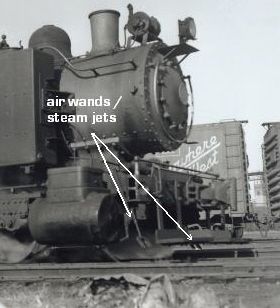 |
.
.
| BEDT used "eared" couplers on all their locomotives,
both front and rear.
These couplers has "extensions" cast onto the top and
bottoms of the normal knuckle part of the coupler. (The knuckle was
cast in one piece at one time and were available as a
special part, not as a recast). |
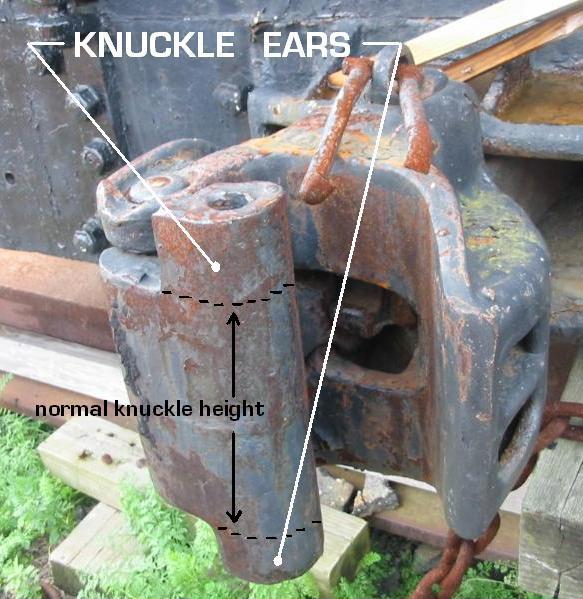 |
.
.
Brakes
All BEDT steam locomotives used the "steam jam" brake method, and did not have air compressors mounted. In the case of the pre-owned H. K. Porters, which from all photographic accounts had air compressors mounted by their previous owners (Navy Fleet Supply Base, Mesta, etc. ), these air compressors were subsequently removed upon the locomotives arrival on the BEDT.
Steam jam brakes (steam piping to a cylinder and rigging which applied the brakes on the locomotive wheels only) was used for stopping the train. Once the freight cars were spotted in their respective location, the individual hand brakes on the freight cars were applied to prevent the car from moving. (See Memoirs for further information.)
.
.
Early images of the steam locomotives, show that they were equipped with a full width footboard; which ran from engineers side, under the coupler and to the fireman's side.
However, later images of the locomotives, show the locomotives to be equipped with "split" footboards, meaning there was an open space under the coupler. The earliest images in my archives that showing split footboards on locomotives, is #11 in 1945, and #15 in 1946.
In some cases, locomotive photos on this website exhibit significant gaps in the timelines of photos shown, e.g.: I have no photos of #14 between circa 1941 and 1956 or #16 between 1923 and 1950; so it is difficult to pin down exactly when BEDT undertook the initiative to modify the footboards to the "split" design.
Based on the photos of #11 and #15, the best we can approximate this modification taking place is circa 1945.
|
|
full width footboard |
split footboards |
.
.
As the saddletanks rotted out on some of the locomotives due to corrosion (after all, they were filled with water and exposed to salt air climate year round); BEDT would weld "skirts" on the bottom. More than skirts actually, BEDT actually "boxed" the bottoms of the saddletanks with steel plate and welded the seams together. Strangely, when the bottoms of the saddletanks were boxed, no front clean out plugs were reinstalled.
As far as can be told, only #15 and #16 received this square bottom modification. #15 apparently received this modification in an out of service period March 8 - May 31, 1962. #16 received this modification prior to that, sometime between June 1959 and September 1960.
#14 oddly received nothing more than expedient patches here and there as they were needed.
|
|
|
|
... |
|
|
|
The sidetanks on 12 and 13, we know from photographs in the Dave Plowden / Railroad Magazine article of April 1961; were simply removed from the locomotive prior to a repair.
The saddletank styles on #10 & 11 however were completely changed from their original design, which were round as delivered from Baldwin. After a rebuild around the mid 1930's, both 10 & 11 received square saddletanks with slightly rounded edges. The cab on #10 was rebuilt at this time as well and details are mentioned above in cab styles. #10 & 11 wore these square saddletanks to their demise.
.
.
#14 Temporary Pilot Replacement
In the John P. Gemeasky photo of 1936, #14 can be seen with an unusual wood pilot. This wood pilot is taller than the original cast steel (compare with space around shank & pocket which is different as well.)
Photos dated both before and after the 1936 Gemeasky photo, show the standard H. K. Porter cast steel pilot.
As best as can be discerned, apparently the original pilot suffered some damage and required removal. A temporary wood pilot with sheet steel end caps was installed. Poling pockets were bolted to this end cap by means of a bolt through the entire pilot beam.
The left image below shows the original H. K. Porter cast steel pilot, circa 1931. The right photo shows the temporary wood metal pilot in September 1936.
By a ca. 1941 photo, the pilot is back to original style, and it remained so throughout the rest of the locomotives service life and into display.
|
|
original H. K. Porter cast steel pilot beam |
temporary wood pilot beam with sheet steel end caps |
.
.
Following the printing of several negatives, this author took note of a variant of lettering on the saddletank of BEDT locomotive #14.
From 1945 (the earliest image on this website of locomotive #14 with BEDT letter logo) until April 1956, the letters "B" "E" & "D" and "T" on the saddletank all had the triangle accent on the vertical leg of those letters.
From June / July 1957 through end on steam operations, the letters "E" and "D" do not have the triangle accent while the letters "B" and "T" did.
Please note: It is believed that the 1962 D. Keller photo is dated incorrectly, based on the fact this is the only "post 1957" photo showing the accents on the "E" & "D" on the fireman's side, and the Reading Railroad gondola has a freshly painted 2/1957 service date stenciled on the side.
Also: the lack of accents on the "E" & "D" applies only to the fireman's side of the locomotive, as photos of the engineers side for all years, shows the letters having accents.
|
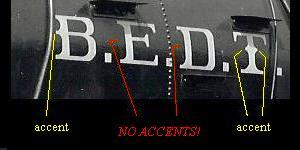 |
1945 - April 1956 |
June 1957 - October 1963 |
However minor this observation may be, it assists us in dating photographs that have no date recorded.
#14 appears to have undergone a shop servicing, which include a complete repaint. It can only be hypothesized that the accents were inadvertently omitted while the lettering was painted.
.
.
This author
has learned that BEDT #14 received a new boiler and firebox after an
explosion in 1953, after having located this information in an
old issue of Locomotive Notes; issue #94, October 1970, published by Roy
Linscott, Jr. Prior to this revelation, I had found no references to this
incident in any other subsequent historical publications or published
sources relating to the BEDT and it's operations and locomotives.
Furthermore, I had previously come across several documents from the
Elizabethport, NJ shops of the Central Railroad of New Jersey, regarding
a new firebox being installed in 1954. This was located in papers sent
to me courtesy of Kurt Bell of the Railroad Museum of Pennsylvania some time
ago. I had previously read about the new firebox being installed, but did
not know of the explosion. I wrongly assumed it was merely extensive maintenance
that had been contracted out by the BEDT and not the result of an "accident".
As the rebuild is dated soon after the explosion, I have concluded that the
CRRNJ shops were contracted by BEDT to do the repairs. What has not been
ascertained through the documents is whether this explosion is the result
of a firebox overheat due to low water and subsequent crown sheet failure
or some other combination of events.
.
According to Joe Roborecky, it has been alleged to him during his tenure,
that at least one firebox explosion on a BEDT steamer was due to a low water
condition with crown sheet failure. Joe unfortunately doesn't recall which
locomotive this occurred on, so there could be a possibility that there was
more than one firebox explosion.
Also, Tom Hendrickson located a newspaper article from
the New York Time archives dated July 20, 1953 regarding this
incident. Unfortunately, a locomotive number is not mentioned in this
article. I have placed an image of the article with the CRRNJ Repair papers,
which you can view through the link below.
Fortunately, Robert Brendel forwarded the following:
FORTY-THIRD ANNUAL REPORT OF THE DIRECTOR OF LOCOMOTIVE INSPECTION
for year ending 6/30/1954:
July 19, 1953
Locomotive 14,
Brooklyn, N.Y..
Crown sheet failure caused by overheating due to low water; gage cock nipples
extended into dripper, obstructing clear view of gage cock discharge; one
killed, seven injured."
BEDT 14 Firebox Explosion Documents
.
.
According to Tom Hendrickson, he recalls reading about a locomotive accident on the BEDT. He states in an email:
"Why was #11 scrapped in 1963? I vividly recall an accident that occurred around this time which I previously mentioned to you. It may have been in late 1962 or early 1963. It occurred during a workshift change about midnight. An article in the NY Daily News will have the title
"1 KILLED, 1 HURT IN RR ACCIDENT"
and will consist of about 4 paragraphs. I remember seeing and reading this article. I recall that my father told me that one of the steam locomotives was damaged so badly in this accident that it was decided to scrap it."
Tom and I have discussed this back and forth now for several emails, and as a result I have laboriously gone through my photo archives examining each locomotive picture and slide. I can determine that #11 was out of service from at least June 1959 (and possibly a few months earlier), as several dated slides and prints have turned up showing #11 sitting on the outdoor "garden track" along the south wall of the enginehouse from this date to February 1961. I have no images after this date, and pictures I thought of #11 being scrapped, were actually of #10. Considering the fact that Ron Ziel, Gerald Landau and a few other noted railfans were practically camped out at BEDT during this time, it strikes me as odd that there are no published or released photos known of this collision event.
So, there is a slim possibility that #10 might have been involved in this collision. One image taken by G. Votava in the Keller archives that is dated June 23, 1962, shows #10 sitting on the south enginehouse track in front of the water plug. So we know it was in service on this date, and there is no damage apparent in this rear left three quarter photo. In this same photo, there is a pile of scrap next to and behind the wood boxcar, which is most likely #11 being scrapped.
We also know that #10 was scrapped in 1963 by different railfan / photographer accounts. The two photos that I have, which are dated 4/18/1963 and July 1963, and which I thought (erroneously) were of #11 getting scrapped; are actually of #10 being scrapped. Due to the advanced stages of the scrapping process in the two photos I own (saddletank, cab, back head are gone), it cannot be determined if there was any significant damage to the locomotive due to an accident.
There are one or two rays of hope in ascertaining more
information about this incident:
Is locating the ICC Accident Report (if one exists, and it should), in a trip to the National Archives I am anticipating.
Is locating the Daily News article and narrowing down the date, and with any luck, the locomotive number.
H. K. Porter Catalog - Specification
Page & Blueprints
Below is a scan of the appropriate page
from the H. K. Porter catalog applicable to BEDT locomotives 12 through 16.
There is a lot of very interesting data that has not been previously published,
such as:
radius of sharpest curve, advised;
radius of sharpest curve, practical;
haulage capacity on the level and various grades, with both extra good and average condition cars and track;
lightest advisable rail usage.

Authors
note:
The weight shown is for a coal / wood burning locomotive.
As BEDT locomotives were converted to oil fired; the oil preheaters, oil strainers, injectors,
valves and related piping added an additional 2,000 pounds, to bring the
total weight of locomotive to 128,000 pounds.
.
On 17 May 2019, this author was most pleased to acquire first generation high resolution digital scans of the H. K. Porter blueprints for locomotive construction numbers 6368, 6369, 5966 and 6780 (US Navy - Fleet Supply Base #1, 2, 3, 4 to become BEDT #12, #13), Mesta Machine Works #4 (to become BEDT #15) and Astoria Light Heat & Power #5 (to become BEDT #16).
Unfortunately the blueprints for c/n 6260 (Mesta Machine Works #5 to become BEDT #14) could not be located, but they are listed as part of the archives, so perhaps they are misfiled and will turn up at a later date. Fortunately, as #15 and #14 are pretty much identical, most of the general dimensions for c/n 5966 (BEDT #15) are equally applicable to c/n 6260 (BEDT #14).
I am deeply grateful to Ms. Marcia Mordfield; assistant archivist for the Canada Science & Technology Museum in Ottawa, Canada. She was gracious enough to expedite the inter-departmental transfer of the applicable blueprints to the production department; as that department is shutting down in June 2019 for six months for installation of new reprographic and computer equipment. This museum has a substantial collection of the original blueprints of the H. K. Porter Locomotive Works. And all the drawings applicable for the BEDT locomotives totaled 14 blueprints (there were other non-BEDT locomotives I wanted the blueprints for as well). Even though I ordered the complete set, I have only published the side and end elevation drawings (how many of you could really be interested in the rivet, fastener & staybolt patterns?)
Anyhow, this required a quick outlay of a substantial amount of funds, and with the financial assistance of Benjamin W. Schaeffer; it was made possible to get all the blueprints scanned at once in a single order, and before the 6 month shutdown.
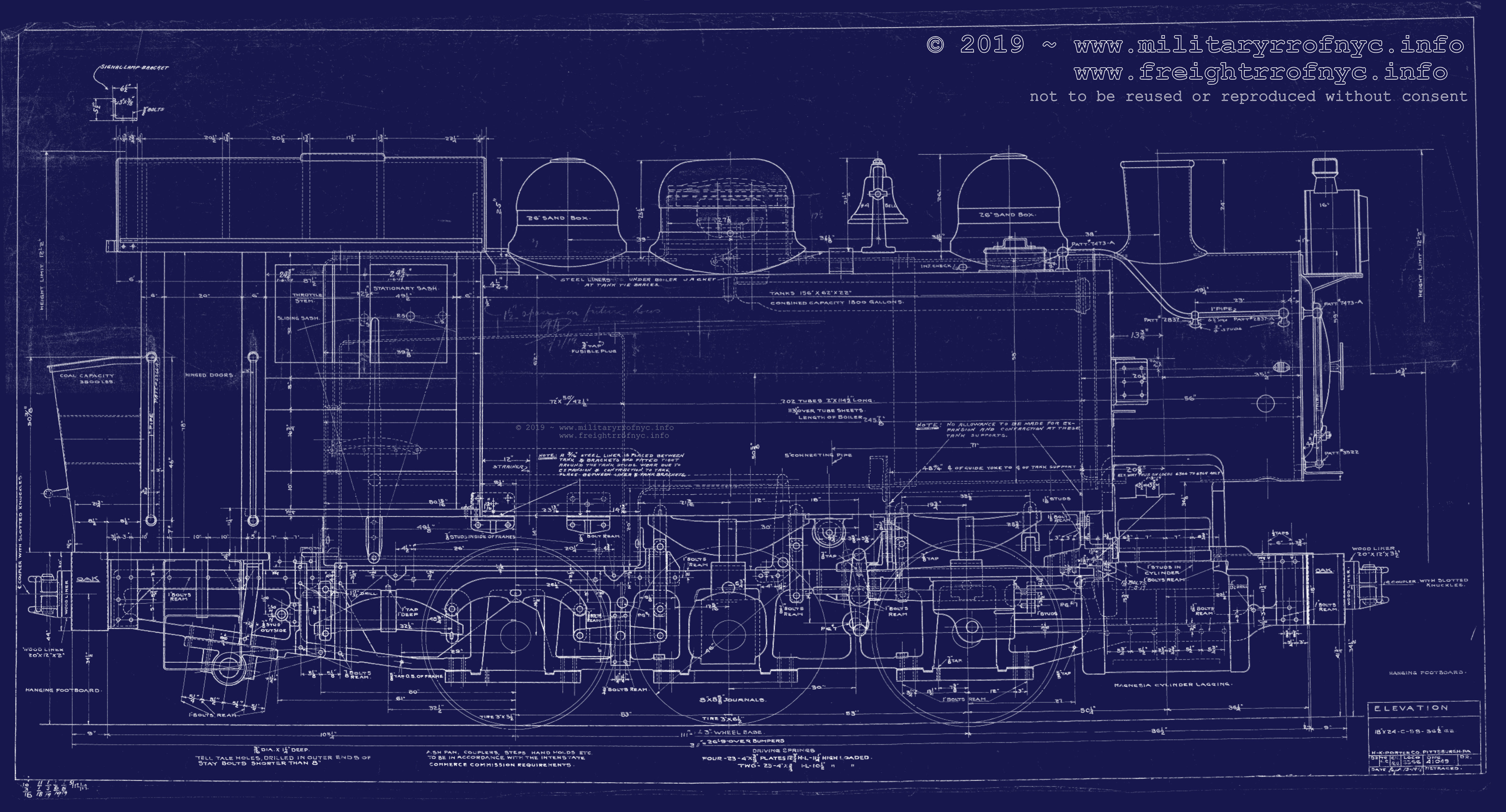 | 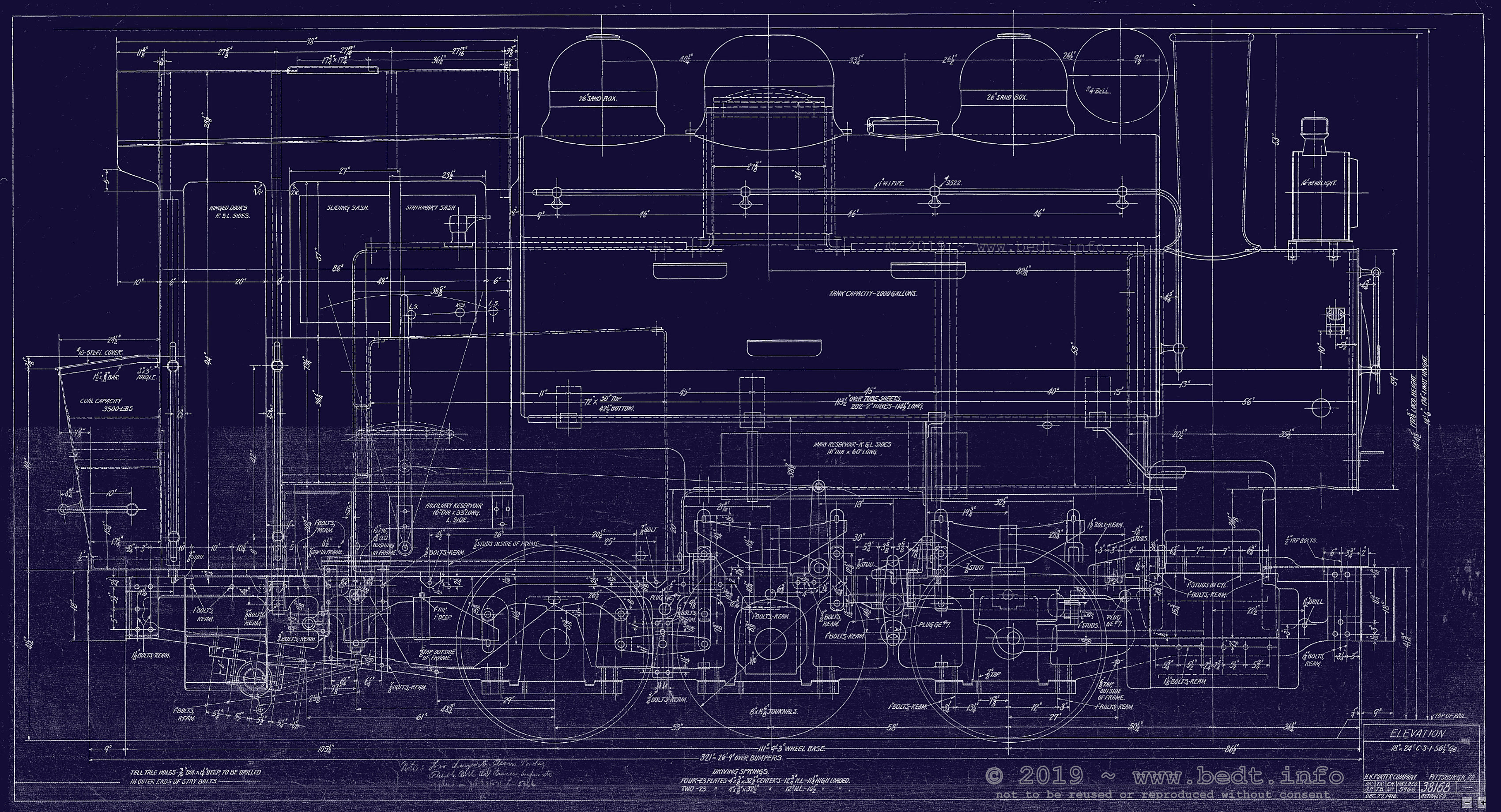 | 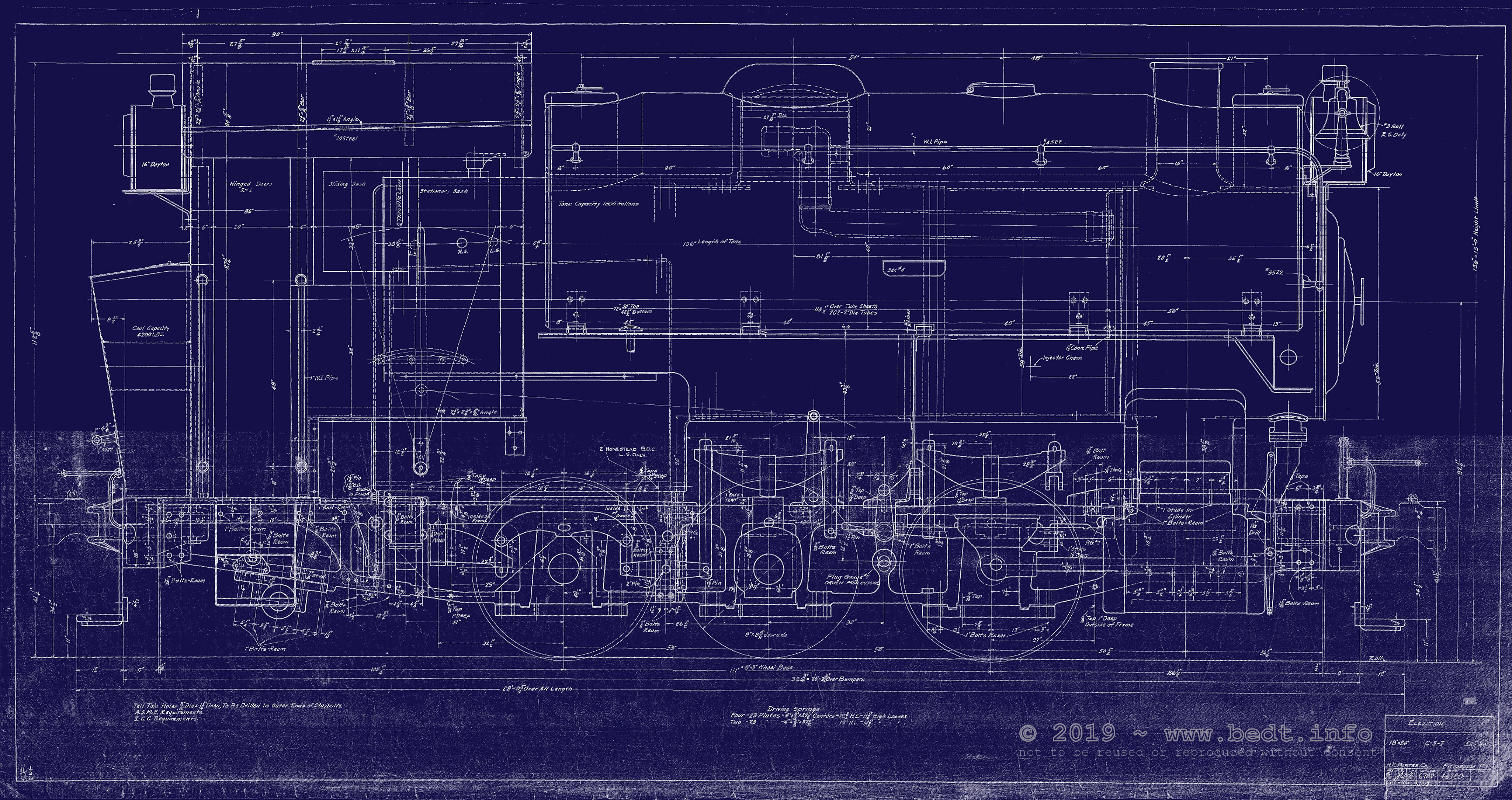 |
| c/n 6366, 6367, 6368 & 6369 (BEDT #12 & #13) | c/n 5966 (BEDT #15) | c/n 6780 (BEDT #16) |
These blueprints may be viewed at the top of each applicable locomotive page. Also, please note these blueprints are as H. K. Porter built the locomotive. They do not reflect changes or modifications made by subsequent owners (if any) or BEDT's conversion to oil, and likewise the coal bunkers are shown on the rear of the locomotive.
.
For several years, I had been troubled over the identification and purpose of a centercab switcher of B-B wheel arrangement and siderods on BEDT property, which is barely visible in four pictures that I acquired from the A. Jaeger collection. These photos are dated February 19, 1961:
(photos enlarged and cropped to show loco in question)
 |
..... | 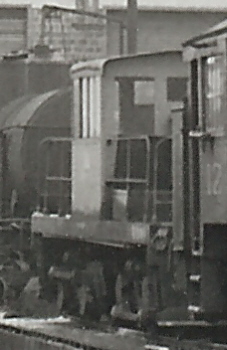 |
..... |  |
..... | 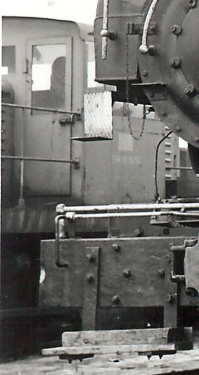 |
After having placed this dilemma on the back burner for a while; I once again took out my high power loupe and tried to identify this engine again. This time I enlisted the assistance of my good friend and Brooklyn terminal railroads cohort, Paul Strubeck. We argued over builders, but eventually discovered it was a Whitcomb locomotive. One of the pictures was at just the right angle to show the nose and the Whitcomb name on the front grill. Then inevitably, came more arguing: which model Whitcomb? With many thanks to North East Rails' Whitcomb pages and Jay Reed's "Critters' Dinkys and Centercabs", Paul and I determined this locomotive was either a 45DE27B or a 45DE28. After a little more debating, we settled on 45DE27B.
Now for the next argument: who in the New York area would have had a Whitcomb loco? Was it an temporary Bush Terminal, New York Dock, or Bronx Terminal unit? A loaner or demonstrator? Or was it just passing through, being shipped from one place or another? (One thing was sure: it certainly was not a BEDT locomotive!) Then, after Paul Strubeck & I discussed it for about 15-20 minutes... It dawned on us... THE BROOKLYN NAVY YARD.
A check of my Whitcomb builders records,
showed several Whitcomb Brooklyn Navy Yard entries for both 45DE27B and 45DE28
units. These locomotives was part of multiple orders from the US Navy of
Whitcomb 45DE27B units, with this unit going to Brooklyn Navy Yard, and the
other units going to other Navy Yards around the US. The Whitcomb Builders
Records sent to me by Allen Stanley show the locomotive going to the Brooklyn
Navy Yard as:
| builder: | model: | built: | c/n: | USN # (orig) |
USN # (renumber) |
prime mover: |
| Whitcomb | 45DE28 | October 1941 | 60097 | 20 |
65-00165 | (2) Cummins 150hp diesels |
| 45DE28 | October 1941 | 60098 | 21 |
65-00166 | ||
| 45DE28 | October 1941 | 60099 | 22 |
65-00167 | ||
| 45DE28A.. | September 1942.. | 60165.. | 65-00170 | |||
| 45DE27B | August 1943 | 60325 | 65-00169 | |||
| 45DE27B | June 1944 | 60326 | 65-00220 or 65-00252 |
In late 2009, I commenced on rescanning my collection to place larger images on this website. When I got to the one of Alfred Jaeger photos of #16, I realized that the USN Whitcomb locomotive was in one of the photos, and even showed the side of the cab with lettering! This is the right most photo above.
But, I now understand that the conclusion that Paul and I came to in regard to this locomotive being a 45DE27B could be wrong. Upon some scanning and enlarging on the cab seen in the last of the four photos above, yielded this result:
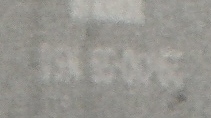

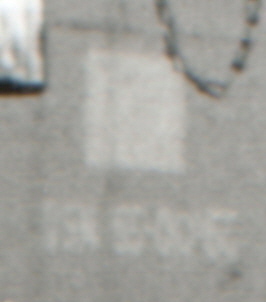
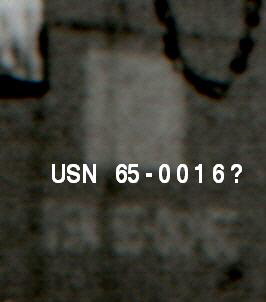
The four images above are at different magnification and resolutions, with the last two being the same except for contrast and notation.
Now, I can definitely make out the USN
65-00. It appears that the bottom half of the 1 is missing, but by the spacing
to the next digit, (a 6); it is in fact a 1, making the number 65-0016. The
last number is where the question lies: To me it appears to be a 5 or possibly
a 6, making the number 65-00165 or 65-00166.
Either of these numbers make this locomotive
a 45DE28. If that last number by chance is a 9, then it is a 45DE27B. Now,
see that light square above the number? That is the original two digit number
painted over. Since only the original order of 45DE28's received the two
digit numbers 20, 21, 22; and subsequent locomotives received the 65-00xxx
series seven digit numbers, 65-00169 (the 45DE27B) would not have had the
original two digit number "painted over".
Therefore, I feel we are looking at either
locomotive #20 / 65-00165 or #21 / 65-00166 which are 45DE28. You draw
your own conclusion and decide.
Now, most of us know; the BEDT carfloated to and for the Brooklyn Navy Yard. The questions that now remains unanswered is; was this BNY Whitcomb at the Kent Avenue enginehouse for: (my thoughts in parenthesis)
|
If any of you out there know the answer to these questions, please... shoot me an email!
.
.
.
STEAM LOCOMOTIVES
OWNED BY COMPANIES PRIOR
TO
THE BROOKLYN EASTERN
DISTRICT TERMINAL
.
.
While this BEDT website entails the detailed history of these steam locomotives after their procurement by BEDT, and while technically two of these companies are not of the New York City area, I still find myself interested in their operations prior to BEDT ownership.
In the end, I felt and photos taken during their prior employment would be better displayed here than on my Industrial Locomotives of Brooklyn, Queens, Staten Island & the Bronx website where this chapter was originally located, so I have transferred them to this location.
.
.
I am actively seeking and naturally I will
pay a rather handsome finders fee for photographs I am also seeking all information on procurement dates, and subsequent dates of sale. If you have such photos or information, please contact me at: |
.
As all of the H. K. Porter locomotives owned by the Brooklyn Eastern District Terminal would be purchased pre-owned, most of them had one previous owner, except for #16 which had two prior owners before coming to the BEDT. Here is a brief synopsis of those locomotives and their prior owners:
US Navy Fleet Supply Base - South Brooklyn Section
- #3 |
... |
US Navy Fleet Supply Base - South Brooklyn
Section - #4 |
The US Navy Fleet Supply Base - South Brooklyn Section, purchased two of the BEDT locomotives new from H. K. Porter. These two locomotives were actually part of a four unit order of identical locomotives for the Fleet Supply Base located along Second Avenue between 29th and 33rd Streets in Brooklyn. The two that where sold to the BEDT are #3 and #4, and the disposition of #1 and #2 are unknown.
| It should
be noted that these locomotives have been erroneously attributed to the Brooklyn Navy
Yard, prior to the "discovery" of the Fleet Supply Base on my associated
website:
Military Locomotives & Railroads of the New York Metropolitan Area - Fleet Supply Base I can only attribute this rather innocent misidentification to the words "Navy" and "Brooklyn" as lettered on the side tank. It was only after I discovered the existence of the US Navy's Fleet Supply Base located along Second Avenue in "South Brooklyn" (the Brooklyn Navy Yard's location can hardly be called South Brooklyn) that the "pieces of the puzzle" came together. So with all due respect to previous historians and works about the locomotives, these locomotives never really operated in the Brooklyn Navy Yard! |
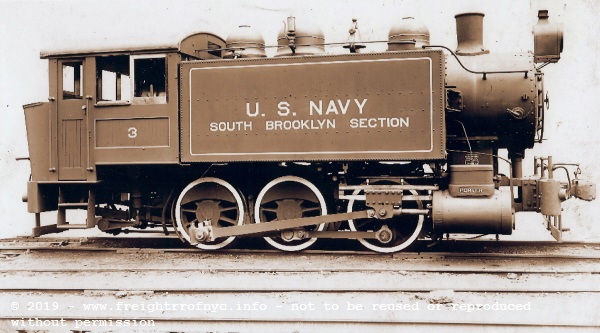
H. K. Porter builders photo: US Navy Fleet Supply Base, South Brooklyn
#3
SMU / DeGolyer Library
As a footnote, I will also accept photos of the sister locomotives #1 and #2 as there were part of the same order and identical, and I am interested in learning the disposition of #1 and #2.
An in depth history of the US Navy Fleet Supply Base - South Brooklyn Section and New York Navy Yard; can be viewed on my other website:
Military Locomotives & Railroads of the New York Metropolitan Area |
.
.
.
..
.
Mesta Machine Works - #4 |
... |
Mesta Machine Works - #5 |
.
.
This firm was located in West Homestead,
PA. It was a very prominent forging, casting and machining facility, with
a capacity to cast and machine very large components. Matter of fact, Mesta
was so well respected (it had forged a great deal of military armament for
WWII), that when Nikita Krushchev (the Soviet Premier) came to the United
States in 1959, he insisted on three destinations: Disneyland, Mesta
Machine and meeting John Wayne!
Pertaining to my interests, Mesta Machine Co. would employ the use of several locomotives over it's history, and had the distinction of owning two locomotives of which would eventually operate for the Brooklyn Eastern District Terminal. As I could find no other references or rosters for the Mesta Machine Company, I have complied one here.
| loco # | builder | c/n | built | wheel arr. | model | gauge | cyl | d.d. | disposition |
| 2 | Baldwin | 28460 | 6/1906 | 0-4-0T | std. | 16" x 24" | 44" | ||
| 4 | H. K. Porter | 5966 | 3/1917 | 0-6-0T | std. | [1] | [1] | to BEDT #15 | |
| 5 | H. K. Porter | 6260 | 8/1920 | 0-6-0T | std. | [1] | [1] | to BEDT #14, 2/1935 | |
| 6 | H. K. Porter | 7203 | 4/1931 | 0-6-0F | std. | 30" x 24" | scrapped | ||
| 7 | H. K. Porter | 7261 | 12/1937 | 0-6-0F | std. | 30" x 24" | scrapped | ||
| Whitcomb | 12664 | 8/1928 | B | 8T CTU | 36" | ||||
| Whitcomb | 60300 | 7/1943 | B-B | 65DE17A | std. | to Allegheny Ludlum Steel, #12; Brackenridge, PA |
[1] = see above BEDT chapters for specifications of these locomotives
As for the two locomotives that were destined to work on the BEDT, Mesta Machine Works had ordered these new from H. K. Porter. The first locomotive, H. K. Porter c/n 5966, was built March 1917. This locomotive would become Mesta Machine Co. #4; and the second locomotive: H. K. Porter c/n 6260, was built August 1920 and would become Mesta Machine Co. #5.
After serving for Mesta Machine Company for many years (15 plus years), the locomotives would be sold. As far as can be discerned, on an as yet undiscovered date; the Brooklyn Eastern District Terminal purchased Mesta #4 outright as no records of a broker have surfaced to date. This locomotive became BEDT #15 .
The sale of Mesta #5 however, would be brokered through Birmingham Rail & Loco, of Alabama; and purchased by the Brooklyn Eastern District Terminal in February 1935 and this locomotive would become BEDT #14. There is a very strong likelihood this locomotive was purchased first and prior to M. M. Co. #4 (BEDT #15).
After many years of searching for photos of the Mesta locomotives without success, I have finally (!!!) located a picture of Mesta Machine Works Co. (MMCo.) locomotive #4 (future BEDT #15). Granted, it is not a roster shot, and it is not a typical working shot, but considering this is the only photo I have been able to locate, I feel it is more than worth sharing and as beggars can't be choosers!
While the cab is not viewable, this locomotive is undoubtably #4, as the photo was taken in February 1918, one year after MMCo #4 (H.K. Porter c/n 5966) was constructed, and as MMCo. #5 was not constructed until 1920. The sand and steam domes are unmistakably H. K. Porter style as well.

"Exterior of the Mesta with Travelling Cranes,
February 11, 1918"
photo courtesy of Historical Society of Western Pennsylvania
Mesta Machine Company collection
.
.
Of particular note is the kerosene headlamp and air pump. Once
at BEDT, the headlamp would be changed to an electric model, and the air
pump removed, as BEDT did not utilize air brakes.
.
.
.
.
Astoria Light, Heat & Power -
#5
H. K. Porter #6780, 0-6-0T, built January 1923
(BEDT #16)
.
.
Astoria Light, Heat and Power was the
first owner for BEDT 16, and purchased new from H. K. Porter #6780. This firm
was located in Astoria, Queens, and manufactured illuminating gas from
coal.
Astoria Light, Heat & Power owned and operated many steam locomotives over its history, and in rather close proximity to Brooklyn, but oddly only one would become a BEDT locomotive, that being BEDT #16.
Not many pictures have been found to date, and the following appears to be a builders photo from H. K. Porter. It is from the A. C. Kalmbach Memorial Library, Kentlein Porter collection:
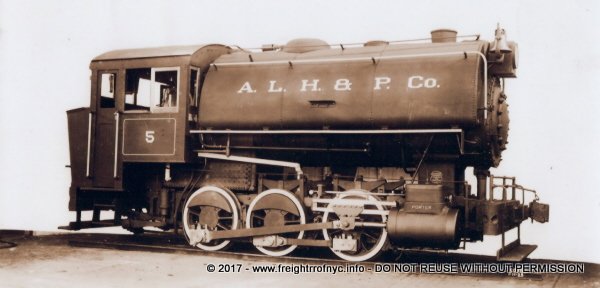
.
..
.
Fleischmanns
Transportation - (number unknown)
(BEDT #16)
.
.
This company, the manufacturer of
Fleischmanns's Yeast, was originally located in Peekskill, NY; and was a
subsidiary of Standard Brands Foods. This firm was the second owner of H.
K. Porter #6780.
After this locomotive served Astoria Light Heat & Power, it made its way to Fleischmanns Transportation in Peekskill, NY. After serving here for an as yet undetermined period of time, it's sale was brokered through Birmingham Rail & Loco of Alabama, to Brooklyn Eastern District Terminal, to become BEDT #16. I find it extremely unlikely that the locomotive was shipped to Alabama, only to be shipped back to New York, so it all likelihood it remained in New York until its sale to the BEDT.
No data whatsoever of it sale by Astoria Light, Heat & Power to Fleischmanns Transportation seems to exist. We only know that this locomotive came to the BEDT in 1939. I would very much like to locate information pertaining to the date of procurement for Fleischmanns Yeast of this locomotive, as well as any photographs of this locomotive in Fleischmanns Transportation livery, as none have surfaced to date.
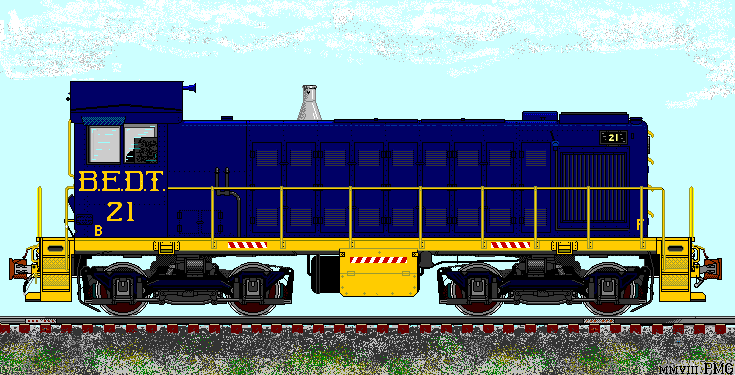
American Locomotive Company - Model S1
The Alco S1 model was introduced in April of 1940, and a production total in excess of 3,200 units were manufactured by March 1961. Partial success of this model was due to the fact that War Productions Board restrictions enacted for World War II, delegated different locomotive builders to construct different application locomotives to avoid duplication of effort and likewise avoid waste of valuable and rationed raw materials. ALCo was therefore assigned to construct switching locomotives, and Electro-Motive Division was assigned road engines.
It should be noted that ALCo models S1 through S4 are very similar in appearance to one another. While I could go into great lengths describing the differences between these models, I feel that is best left to the already published references on ALCo locomotives and diesel spotter guides. It should be taken into consideration and remembered for future reference; all of BEDT's diesel locomotives were S1 models, even though it can be found intermittently that some photographs, slides and auction descriptions erroneously list them as S2.
Speed MPH |
Tractive Effort |
Time Limit |
Grade - (compensated for curvature) |
||||||
Level |
0.5% |
1.0% |
1.5% |
2.0% |
2.5% |
3.0% |
|||
| 5.0 | 34,000 | 90 min. | - |
2240 | 1290 | 888 | 667 | 526 | 429 |
| 7.5 | 24,700 | Cont. | 5200 | 1590 | 908 | 617 | 457 | 355 | 285 |
| 10.0 | 18,900 | 90 min. | 3870 | 1188 | 669 | 448 | 326 | 248 | 194 |
| 15.0 | 12,900 | Cont. | 2460 | 765 | 420 | 272 | 189 | 136 | 100 |
| 20.0 | 9,800 | Cont. | 1700 | 540 | 289 | 179 | 118 | 78 | 51 |
| 25.0 | 7,800 | Cont. | 1210 | 392 | 203 | 119 | 71 | 40 | - |
| 30.0 | 6,350 | Cont. | 882 | 287 | 141 | 75 | - |
- |
- |
| 35.0 | 5,100 | Cont. | 601 | 197 | 87 | - |
- |
- |
- |
| 40.0 | 4,100 | Cont. | 415 | 125 | 44 | - |
- |
- |
- |
Based on Davis train resistance formulae for standard 4-axle cars with an average weight per car of 40 tons.
BEDT diesel operations began with the purchase of an American Locomotive Co. / General Electric model S-1: ex-Union RR #453 in 1962. The S1 model was a popular locomotive for switching, and in some cases short haul road assignments.
The BEDT would purchase three more ALCo / GE S1's from Missouri Pacific (New Orleans Lower Coast). These first four diesel locomotives would completely supplant the steam locomotives at the BEDT on October 25, 1963.
The BEDT would then go on to purchase two more S1's from Erie Lackawanna to give the BEDT a total of six ALCo / GE S-1's, with #26 being acquired as late as 1973 and being the final locomotive acquisition for the BEDT. These six ALCo S1's would be the only model diesel-electric locomotive that was owned by the BEDT.
A GP at BEDT?
According to Jose Feliciano; he specifically recalls seeing a non-ALCo high hood locomotive working at BEDT very briefly sometime in 1977 or 1978. Jose has; through his expertise, identified this anomaly as either a GP7 or GP9 and possibly a GP18 (all have same carbody). The entire locomotive was painted a dull flat yellow or beige primer. There were no discernible markings or livery. He recalls it was not being there long.
As he used to live at #60 North 8th Street on the third floor of a walk up apartment building that had a fantastic overall view of the BEDT operations on the north end of the property out of his window, Jose would watch BEDT operations for hours on end. He is absolutely certain of his recollection as the locomotive was significantly larger than the S1 locomotives working near it, and as it was a different color.
Unfortunately, Joe Roborecky (retired BEDT engineer, 1968-1983) does not recall any non-S1 locomotives being utilized by BEDT other than NYD 44 Tonners throughout his tenure. As we can understand, it is unlikely to confuse a GE 44 tonner with an EMD GP 7/9/18 due to the great difference in size and body style. However, there is always the slim possibility that Joe could have not been assigned to Kent Avenue operations or even on vacation during those few days when this unknown locomotive was tested. It could even be a locomotive brought over from Greenville for an expedient repair.
It goes without saying that Jose, Joe and myself (and I'm sure other BEDT fans as well) desire very much to know more about this situation. If any reader can provide any further information whatsoever, please do not hesitate to contact me at bedt14@aol.com. Your submissions will of course be credited to you.
Returning to the BEDT S1's, and as all
S-1's were of same general builders construction specifications, the
following table (which is incomplete) applies to all BEDT S-1
locomotives:
| locomotive builder: | ALCo Schenectady Shops, NY |
| electrical components: | General Electric |
| wheel arrangement: | B-B |
| weight: | 99 tons |
| length: | 44' 6" |
| height: | 14' 6" |
| width: | 10' 2" |
| tractive effort (at 30% adhesion): | 59,675 lbs |
| wheel diameter: | 40" |
| prime mover: | McIntosh & Seymour 6-539 - 4 stroke |
| # of cylinders: | 6 |
| firing order: | 1-3-5-6-4-2 |
| idle rpm / max rpm | 240 / 740 |
| horsepower: | 660 |
| airbrakes: | 14ET * |
| generator: | GT-552 |
| traction motors: | GE 731 |
| gear ratio: | 75:16 |
| max. speed: | 60 m.p.h. |
| trucks: | ALCO "Blunt" |
| lubricant capacity: | 80 gallons |
| coolant capacity: | 220 gallons |
| fuel capacity: | 635 gallons |
| fuel type: | diesel fuel |
| number produced: | 540 |
* = Footnote: BEDT discontinued use of the automatic (train) air brake controls in the cab, but the independent loco brakes were left intact and used for all braking.
B.E.D.T.
Diesel Locomotive Roster
Click on number plates to view images of
that locomotive.
|
||||
| build # | build date |
former owner(s) |
acquired |
notes & disposition |
| 75351 | 8/1947 |
Union
RR #453 Duffy (RR Equipment dealer) Silcott (RR Equipment dealer) BEDT / BEDT (NYD) |
new |
Stored operational on carfloat
at Fulton Terminal. Reactivated 3/1985 and became NYCH #21: Retired unknown date. Scrapped 7/2006 |
|
|
||||
|
||||
| 75525 | 10/1947 |
New Orleans & Lower Coast #9013 Missouri Pacific #6604 Duffy (RR Equipment dealer) Silcott (RR Equipment dealer) BEDT / BEDT (NYD) |
new |
Became NYCH #22 -
8/1983 Used in regular operation. Retired unknown date. Scrapped 7/2006 |
|
|
||||
|
||||
| 75526 | 10/1947 |
New Orleans & Lower Coast #9014 Missouri Pacific #6605 Duffy (RR Equipment dealer) Silcott (RR Equipment dealer) BEDT / BEDT (NYD) |
new |
Stored operational November
1976. Reactivated 4/1979. Stored operational on carfloat 8/1983. Acquired by NYCH, stored unused and scrapped 01/1986. |
|
|
||||
| 75527 | 10/1947 |
New Orleans & Lower Coast #9015 Missouri Pacific #6606 Duffy (RR Equipment dealer) Silcott (RR Equipment dealer) BEDT / BEDT (NYD) |
new |
Out of service May 1978. Acquired 8/1983 by NYCH. Stored & cannibalized for parts. Scrapped 1986. |
|
|
||||
| 74962 | 10/1946 |
Erie #307 Erie Lackawanna #307 BEDT / BEDT (NYD) [a] |
new |
Became NYCH #25 8/1983. |
|
|
||||
| 75354 | 8/1947 |
Erie #313 Erie Lackawanna #313 Neosho Construction #460 American Electric Power / Central Ohio Coal (Muskingum) #313 Silcott (RR Equipment dealer) BEDT / BEDT (NYD) |
new |
Out of service prior to
8/12/1983 Stored on carfloat minus front & rear steps. Acquired by NYCH for parts. Scrapped 1986. |
As
of July 13, 2006, it saddens me to learn that BEDT #21 and #22 have fallen
victim to the oxy-acetylene flame sometime earlier this week.
|
||||
[a] = see Equipment Footnotes, Bicentennial Celebration
.
.
.
Air Brakes "Train Line"
Like the steam locomotives before them, BEDT would not use "train line" air brakes on the diesel locomotives for stopping the train. With the diesels, air powered locomotive brakes were the sole method of stopping.
However, examination of photographs of the diesel locomotives revealed that after 1979, air brake hoses can be seen on locomotives #22 and #25.
It is believed, that after the merger of New York Dock and Brooklyn Eastern District Terminal in 1978, that to use a BEDT locomotive at Bush Terminal (or Fulton or Atlantic Terminals if needed), air brakes were needed as New York Dock used the "train line" or "automatic" air brake set ups on their locomotives.
Therefore it is believed, by the air lines as seen in the photographs, that #22 and #25 were re-equipped with air brakes to be compatible with operations at Bush Terminal. None of the other BEDT locomotives appear to have been refitted with train line air brakes, and #21 was refitted with automatic train line air brakes after being absorbed by the New York Cross Harbor RR.
(See Memoirs for diesel locomotive brake methods.)
.
.
Footboards & End Plates
Pursuant to enactment of FRA regulation 49 CFR Part 231.30 - Locomotives used in switching service.
Subsection D: End footboards and pilot steps;
(1) Except for steam locomotives equipped as provided in 231.16, locomotives used in switching service built after March 31, 1975, may not be equipped with end footboards or pilot steps.
(2) Except for steam locomotives equipped as provided in 231.16, locomotives used in switching service built before April 1, 1975, may not be equipped with end footboards or pilot steps after September 30, 1978. Whenever end footboards or pilot steps are removed from a locomotive, the uncoupling mechanism and horizontal end handholds of the locomotive must be modified to comply with paragraphs (f) and (g) of this section.
As such, the front and rear pilot footboards (where a brakeman could stand while the locomotive was switching cars) were removed from diesel locomotives operating in the United States. Likewise, all locomotives in use at the BEDT had their footboards removed to comply with this regulation.
Also, according to FRA regulation 49 CFR 229.123; after January 1, 1981, each lead locomotive shall be equipped with an end plate that extends across both rails, a pilot, or a snowplow. The minimum clearance above the rail of the pilot, snowplow or end plate shall be 3 inches, and the maximum clearance 6 inches. However, it should be noted that BEDT locomotives show this endplate was installed before the enactment.
.
|
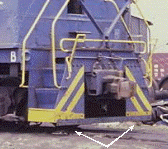 |
footboards mounted |
footboards removed |
.
.
Bell Mounting Locations.
Bell mounting locations varied between
two groups of BEDT diesel locomotives locomotives. Locomotive numbers 21,
22, 23 and 24 had their bells mounted under the frame in front of the battery
box (engineers side).
However, locomotive numbers 25 and 26 had their bells mounted
on the top of the hood, in front of the cab by the fireman's upper middle
window. This bell location was the standard location for bells on Erie /
Erie Lackawanna ALCo locomotives, (which is where locomotives #25 and #26
originally came from).
.
.
Variants and Differences
between BEDT diesel locomotives: Paint Schemes, etc
While to the average viewer the BEDT diesel
locomotives appear alike, there were actually many subtle differences in
appearance and paint schemes between the six locomotives. There were four
basic but distinctly different paint schemes for the locomotives that were
owned by the BEDT. Making matters complicated, was the fact that there were
variants to the schemes as well.
Not all the locomotives however, wore each and every version
of the paint schemes (i.e: only #21 wore the Dark Blue / Pale Yellow, #24
would not wear a white frame or hood stripe even though it would carry white
letters and only #25 wore the Red Bicentennial Sash).
Also to be taken into consideration, were the various changes
that took place to the appearances of the locomotives to reflect FRA
regulations and safety equipment.
So, to better display these differences, I have created a webpage
illustrating and outlining these variants between the diesel locomotives.
While this chart may be of some interest to the casual observer, it will
most likely prove to be indispensable to those trying to date an undated
image and perhaps be even more of assistance to the "rivet counter" modeller
who wants a particular model to be "spot on" accurate for a particular time
frame! This variation list with illustrations can be viewed here:
.
The lists on this page is by no means complete or finalized. Please feel free to submit your observations to me by email: bedt14@aol.com
In regards to the diesel locomotives,
all but one of the BEDT ALCo diesels have been scrapped. Numbers 23, 24 and
26 were purchased by the New York Cross Harbor Railroad for parts "donors"
to keep 21, 22 and 25 running. Throughout the years, 23, 24 & 26 would
meet their fate and would be scrapped, when no more viable parts were left.
Numbers 21 and 22 would continue to serve in the employ
of the New York Cross Harbor Railroad, which operated on the former Bush
Terminal property. They would eventually be taken out of service and stored,
with 25 remaining the sole "BEDT" locomotive in operation. Not too long after,
number 25 would also be taken out of service, and replaced with newer model
switchers.
Eventually the end came for numbers 21 & 22, as after many
years of storage, they were scrapped in the Greenville, NJ yards in July
2006, along with other obsolete (their view, not the authors!) New York Cross
Harbor locomotives.
A lucky BEDT historian (ahem...) was fortunate enough to find
four (and only four, no others were seen) of #21's engine doors (and one
sand filler cap from NYCH #11's ) in a pile of scrap metal in New Jersey,
and rescued them:

July 2006 - Greenville, NJ
.
.
One of the doors, still has traces of the letter "B" under a coat of blue paint. It is the announced intention of this historian to repaint and reletter each door "B" "E" "D" "T". When this occurs, it will be the last remaining link to BEDT diesels.
.
.
The Sole Surviving BEDT Diesel
Number 25 however, would be "secretly"
moved into the Cross Harbors' enginehouse, stripped, restored and repainted
into a New York Central scheme. Luckily, the same historian who rescued
#21's engine doors, went to visit the old Bush Terminal properties and
enginehouse, when I (oops sorry... he) knocked and someone came to the door
and invited him in. What should present itself, but none other than #25 stripped
to bare metal! After asking for permission to photograph, which was granted,
this author "went to town". The people restoring #25 were volunteers and
that is how this author learned #25 was heading to Riverside Park, in NYC
livery. Pictures of #25 stripped and in the NYCH enginehouse can be seen
on #25 page.
According to a New York Times article "A Chugger Floats to Stardom
as a Park's Centerpiece"; it was purchased for scrap price by the developer
for the park, then donated to the City of New York, who has the intent to
display the locomotive in Riverside Park South, Manhattan. Being that
Riverside Park South is ex-New York Central territory, it is apparent that
someone thought of having a "New York Central" locomotive was fitting. Anyhow,
this event took place in August 2006.
And thus ends the story of the Brooklyn Eastern District Terminal
as an operation, but not as a memory. Its history lives on in the thousands
of photographs that countless railfans took of the Brooklyn Eastern
District Terminal. Its history is also memorialized in its steam
locomotives, which have been preserved with the intent of keeping them "B.
E. D. T." (That is, all but #15 who is now operating as Thomas the Tank Engine
for Strasburg Railroad, in Pennsylvania) and all but one of the diesel
locomotives are gone, and unfortunately; that sole survivor eludes her true
heritage from Brooklyn.
.

"Roster On A Barge" - ca. September 1983
(combined locomotives of Brooklyn Eastern District Terminal and New York
Dock)
unknown photographer
A. Miller collection
.
Tugboats
All the carfloats and lighters mentioned
below, were moved to and from the terminals throughout the years by a small
fleet of tugboats. These tugboats varied in power in the later years, and
ranged in horsepower from 350-1300, averaged 95' in length and about 190
gross tons. The early tugboats were of wood hull construction, but later
tugboats would eventually be built with steel hulls.
The Brooklyn Eastern District Terminal owned many tugboats during
their existence and appear to have had at least two in service at any one
time. In 1916, the Public Service Commission Report states the BEDT had 5
tugs. Having such a decent pool of tugboats throughout it's history, turned
out to be to the advantage of the BEDT, as on September 30, 1920; the dredge
"Raritan" (belonging to the United States) collided with the steam tug Integrity
in New York Harbor. Damage to the Integrity was (in 1920 dollars) $26,114.57.
with a lawsuit following the collision with the BEDT seeking demurrage.
[BEDT V. US #39, 287 U.S. 170; Oct, 21, Nov 14 1932). A
copy of the pertinent parts of the lawsuit is listed in Memoirs section of the main page.
The tugboats were steam powered at the turn of the century and
fired by coal. Then newer steam powered tugboats fired by Bunker C fuel,
were purchased about mid 1910's through the 1940's. Eventually diesel-electric
power designs replaced those tugs in the late 1950's which precipitated the
BEDT to switch from steam locomotives to diesel.
While almost all of the tugboats prior to the 1970's were registered
to the Brooklyn, NY port, and directly to the Havemeyer & Elder
firm. However, the vessels "Petro Arrow" and "Petro Flame" had Philadelphia,
PA ports of registry. At this time, it is unknown to whom these vessels
were registered to in Philadelphia, but perhaps it is one of the petroleum
or tobacco companies that became involved in the ownership of the BEDT during
the 1970's.
The tugboats names and specifications, along with photographs
are listed in the "Tugboat Roster", and can be viewed through the link in
the chapter below.
.
Carfloat,
Lighter & Scow Overview
.
Carfloats
The Brooklyn Eastern District Terminal used
many carfloats to receive and dispatch rail traffic. These carfloats are
essentially flat barges with two or three tracks along the top. These barges
would then be loaded with rail cars and floated across New York Harbor to
BEDT. The early carfloats were wood hulled,
and starting around 1905 they were constructed of steel plate. The carfloats
ranged in length from 290 to 324 feet, with capacities from 12 to 22 cars.
There were three basic types of carfloats used by the Brooklyn
Eastern District Terminal.
.
Three Track Interchange
The most common type of carfloat seen in use by the BEDT was the three track interchange type. This design was used to carry freight cars to and from the various Rail Marine terminals located throughout New York Harbor.
Freight cars would be put aboard at one terminal, the carfloat towed by tugboat to its destination terminal, and unloaded. Freight cars from that location would be put aboard in and the carfloat towed to another destination, and the process repeated.
.
Platform or Station
Several of the carfloats once owned by BEDT, are the "Station" or "Platform" type. A "Platform" or "Station" type carfloat is a carfloat with two tracks instead of three. In place of the middle track, a platform equal in height to the floors on the boxcars (like a railway platform), ran down the center (lengthwise) of the carfloat.
This raised platform eliminated the middle track on the carfloat, and while it lowered the car capacity of the carfloat, it enabled the carfloat to be moored to any pier and enabled companies to directly load or unload freight while the freight car still on the carfloat. The illustration below shows the three basic types of carfloats utilized by the Brooklyn Eastern District Terminal.

Centerpipe
In the later years, BEDT reconfigured
two carfloats as a "centerpipe" types. These "centerpipe" carfloats were
converted from platform / station carfloat #26, and Pennsylvania RR #588 to
transport and unload covered hoppers for H. & M. Schaefer Brewery, when
the Lehigh Valley ceased service to that firm in 1975.
This centerpipe carfloat was similar in track layout design
to a platform float, with two tracks on either side of a deckpipe mounted
waist high with capped hose couplings every 10 feet or so, down the long
axis of the float. This arrangement allowed short hoses to coupled from the
bottom of the hoppers to the deckpipe, and then a hose from the end of the
carfloat to the Brewery. By this method, brew ingredients (yeast, barley,
hops) in the covered hoppers could be siphoned or drawn off the cars by air
pressure and vacuum (pneumatics), while the hoppers were still on the carfloat
and thereby eliminating the need to unload those freight cars at Schaefer
Brewery.
Now, following some research Paul Strubeck commenced on 17 November
2011, and in part to his ever growing knowledge on marine vessel appurtenances
learned from his working on the "Cornell" (a former Lehigh Valley
RR tugboat and now privately owned), the following information has been
discerned.
Therefore, Paul and I have come to the conclusion that BEDT
centerpipe carfloat #32 is NOT the Lehigh Valley centerpipe
carfloat (as previously stated here) and seen on page 60 (Jay Held photo)
of New York Harbor Railroads, Volume 2 by Thomas Flagg; but in fact
BEDT #32 was converted to a centerpipe carfloat from a Pennsylvania RR platform
/ station carfloat.
The reasoning behind this change of opinion is that Paul
noticed that BEDT #32 has Pennsylvania RR style "button" bitts and box style
track bumpers. The Lehigh Valley centerpipe did not have button style
bitts, and neither did BEDT 26. I had concluded BEDT might have simply added
or changed the bitts and bumpers to their preferred style. But Paul
also pointed out the BEDT #32 was a long style carfloat with a segment of
deckpipe to the rear of the platform. The Lehigh Valley carfloat did not
have this and their platform was located at the extreme end of their deck
pipe, whereas both BEDT 26 & 32 the platform is offset from the rear
end of the deckpipe. So, all those things considered, it is apparent we are
now looking at a third centerpipe carfloat.
Furthermore, another piece of information leading to this opinion
stems from when BEDT 26 was converted from platform / station to centerpipe,
BEDT took the platform off the carfloat (cutting the platform legs where
they were welded to at the deck of the carfloat) and made a loading dock
out of it for parallel to track 9A5 located between North 9th and
North 10th Streets. This "instant" loading dock can be seen quite
clearly in the Robert Hart Sr. photo on page 24 of September 1992 issue of
Railpace. That platform has a distinctly curved roof which matches the platform
roof on BEDT carfloat #26 before it was converted (refer to images of BEDT
carfloat #26 prior to conversion on the
Marine
Equipment page).
Now coincidentally, I also have two images taken by Tim Darnell
dated October 1975 of BEDT locomotive #21 (see
BEDT #21 image
page) next to a platform which is clearly taken off a platform / station
carfloat and marked with the number 588 in white block style numerals
on a red beam. This number, font and color combination by the way, very
conveniently conforms to Pennsylvania RR marine equipment numbering system
and livery colors. Furthermore, this platform roof clearly is a silver colored
corrugated sheet made of tin or galvanized steel. And by referencing
page 100 of New York Harbor Railroads in Color Volume 2, by Thomas Flagg,
almost all of the station carfloats seen are of the same color combination
and roof style & color! For the record, it is not seen in any earlier
dated images.
Now if one keeps in mind the date this all taking place, (via
Schaefer Brewery's
own History webpage), Schaefer Brewery announced closing the Brooklyn
plant in 1975:
"By 1975, it was obvious that one of less efficient
plants would be closed. In 1976 Schaefer announced the closing of the Brooklyn
plant. This announcement, only one week after Rheingold disclosed its plans
to also shut down in Brooklyn, left Brooklyn and New York City without a
single producing brewery."
.
.
By previous historical accounts, Lehigh
Valley RR announced it would be dropping Schaefer as a customer almost
immediately after Schaefers announcement. This left Schafer without a shipper,
and BEDT stepped in to fill that void. This would mean BEDT would have
needed at least one (but more likely two) centerpipe carfloats in servicing
Schaefer; i.e.: one carfloat would be loaded with full hoppers and moored
to the bulkhead at Schaefer (thereby taking it out of service temporarily)
as Schaefer would draw off the contents, and another carfloat would would
be able to have the recently unloaded hoppers removed and consequently be
loaded with full hoppers at BEDT. Then BEDT would just swap out the carfloats
at Schaefer Brewery and the process repeated.
Now, we've always assumed BEDT took possession of Lehigh Valley
RR's centerpipe carfloat, but upon further reflection, Paul's observations
and if previous historical accounts are factual (and we have no reason to
think otherwise) that Lehigh Valley dropped Schaefer Brewery as a customer
when Schaefer announced they were leaving New York. Obviously for their own
reasons, Lehigh Valley RR did this with very little notice (and in my opinion
quite unprofessionally). Therefore, if Lehigh Valley was being crass, why
would they (Lehigh Valley) do an "about face" and act all benevolent by selling
to BEDT their (Lehigh Valley's) centerpipe to continue service to Schaefer.
Why help competition? Why not Lehigh Valley just keep servicing Schaefer
Brewery themselves?
So if in fact Lehigh Valley took this route, BEDT would probably
need two centerpipe carfloats (as explained above). One we know was converted
from BEDT #26, and BEDT #32 now appears to have been converted early to mid
1975 from Pennsylvania Railroad platform / station carfloat #588. The reason
why I believe this to be is, BEDT already developed the expertise and knowledge
in taking station/platform carfloat once before (#26) and converted it to
a centerpipe. Therefore, they already had the "experience" and knowledge
to do it again. Only this time they purchased Pennsylvania Railroads platform
/ station carfloat #588 to do the job. It is presumed that PRR had quite
a bit of surplus marine equipment with what the declining carfloat business
in the New York Harbor area during this decade and/or the impending formation
of Conrail. So, BEDT did what they already knew how to do: remove the platform
off a platform / station carfloat and convert to a centerpipe, thereby giving
them a second centerpipe carfloat.
And, just as naturally, with all railroads suffering in the
fiscally crunched 1970's), they did not throw anything away, and so BEDT
used the platform as a loading dock up at Pidgeon Street where we see it
in the photos of BEDT #21 commencing October 1975.
Yes, it is a lot of circumstantial evidence, (but we are not
trying to convict someone in a criminal court), just find out when and where
BEDT acquired their centerpipe carfloats! In conclusion, I feel both
Paul and have followed a very logical line of thinking with the aforementioned
conclusions. What this hypothesis does do, though is raise the following
questions:
Did Lehigh Valley have a second centerpipe carfloat for swapping out at Schaefer?
What became of Lehigh Valley's centerpipe carfloat(s), but most importantly,
the reason for dropping Schaefer Brewery on such short notice.
.

Essentially, the "centerpipe" carfloats was a floating wharf,
and eliminated the need for building a float bridge and team tracks on land
at the Schaefer facility, and was a cost effective method of delivery.
In all actuality, the BEDT centerpipe carfloats were not in
use long, seeing how BEDT picked up Schaefer as a customer in 1975 and Schafer
closed its Brooklyn plant towards the end of 1976 or early 1977. It leaves
one to wonder even why BEDT would go through the expense of converting those
carfloats for such a short duration, knowing Schaefer was closing the
plant and leaving the New York area. Unless of course BEDT was hedging a
bet on a last minute reprieve of Schaefers decision to close the plant, and
it would stay open. But, as we all know now, Schaefer closed the plant.
.
The Odd Ball Carfloat
Coming to
light in March 2012, is a unique carfloat operated by the Brooklyn Eastern
District Terminal.
This carfloat was numbered 31, and is a station / platform carfloat
of usual design. However, as brought to my attention by Benjamin Schaeffer,
there was a platform above the roof of the regular platform. Without actually
seeing it, Ben described the arrangement an elevated platform above the standard
platform roof, with steel staircase up to the raised platform. Attached to
this platform was an "L" shaped pipe with a small pulley on the end like
the davits for lifeboats on ships. This davit swiveled as well. Ben seems
to recall this was originally a New York Central carfloat before the Brooklyn
Eastern District Terminal acquired it.
Ben's original thought was the raised platform was used to assist
the floatman navigating the float and relaying the information by hand signal
to the captain of the tugboat. But Ben noticed this raised platform was at
the stern of the carfloat. My original thought was that the carfloat
was used in transport of insulated non-mechanical refrigerator cars (known
as "reefers" in railroading). The platform would assist workers in the placing
of blocks of ice in those reefer to keep their loads chilled. As Brooklyn
Eastern District Terminal serviced quite a few meat packers on North 5th
Street, this seemed like a logical conclusion. The davit hoist logically
would be used to lift the blocks of ice.
Ben informed me that he had images of the carfloat and would
get them to me at the upcoming 2012 Clark, NJ Railroadiana Show. In the meantime,
Ben found an image of this carfloat in Tom Flagg's book "New York Harbor
Railroads in Color, Volume 2", p113. The image taken by Tom, was taken from
the Williamsburg Bridge and the carfloat is really in the distance. But we
were able to discern that carfloat has covered hoppers loaded on one of the
tracks.
When I took possession of Ben's images and actually seeing
the carfloat up close in those images, it became obvious this was not an
"icing" platform. There is a safety railing around the entire circumference
of platform (with the exception of access to the stairs) and the raised
platform is raised several feet higher than the roof of the platform. This
would preclude workers of exiting the raised platform with the block of ice,
without having to first climb over the safety rail and jump down to the roof
of the platform.
Then Joe Roborecky, Paul Strubeck and I took note of small diameter
pipe (1 1/2 to 2 inches in diameter). This pipe is mounted to the outside
edge of the carfloat and upon passing the roofline of a freight car, turned
inwards 90 degrees (from vertical to horizontal) towards the raised
platform, where it was secure to the safety rail. A handled valve can be
seen on the pipe, and the pipe continued under the top safety rail to the
other end of the raised platform, where it now turned 90 degree again from
perpendicular to the carfloat to parallel with the carfloat. Here the pipe
simply ends. Had it not been for that valve, we would have simply written
the pipe off as electrical conduit. But obvious it was meant to carry something.
Being of such small diameter, the flow capacity of the pipe could not be
great.
In considering the fact we see the carfloat with covered hoppers,
we raised and subsequently disproved the carfloats use as an auxiliary flour
carrier. Then I postulated that the carfloat might have been have been used
to receive the used diatomaceous earth used for filtering in the sugar process,
but in reviewing photos of Domino refinery, failed to reveal anything.
Then Paul raised the possibility that this carfloat might have
been an attempt at a primitive centerpipe carfloat, with the centerpipe mounted
under the main platform. Hoses then could be connected to the round
openings seen along and under the main platform deck. However, other images
of New York Central platform carfloat show similar openings, so I do not
think they were hose connections, but possibly just tubes used for running
hoses from one track under the platform to the other track. But taking upon
his original thought, I came up with the following:
When Lehigh Valley decided to cease service to Schaefer Brewery,
they may or may not have lent their centerpipe carfloat to Brooklyn Eastern
District Terminal for use until Brooklyn Eastern District Terminal could
actually make a centerpipe of their own. Joe Roborecky feels Lehigh
Valley did lend Brooklyn Eastern District Terminal the Lehigh Valley centerpipe,
I however do not and my reasoning for this as I've stated before is, if Lehigh
Valley dropped Schaefer before Schaefer closed Brooklyn plant in the first
place and for whatever reason (Lehigh Valley being cash strapped? Schaefer
owed them money?) they were not being nice to Schaefer Brewery (putting it
nicely!),
Now since Lehigh Valley dropped Schaefer Brewery, why would
Lehigh Valley make it easy for Brooklyn Eastern District Terminal and lend
them their (Lehigh Valley) centerpipe for Brooklyn Eastern District Terminal
to continue service to Schaefer? Furthermore, we have never seen the Lehigh
Valley centerpipe in tow by Brooklyn Eastern District Terminal tugs or moored
at Brooklyn Eastern District Terminal. (Yet...)
This being the case, Brooklyn Eastern District Terminal was
hard pressed to institute "direct from carfloat" service for Schaefer Brewery,
and get it going fast. So Brooklyn Eastern District Terminal shop
mechanics "threw" this raised platform on one of their existing platform
carfloats (which happened to be #31). This platform would reach the connections
for the curved side by side siphon pipe mounted on the hinged 'A' Frame and
overhanging the bulkhead at Schaefer.
The davit seen on #31's raised platform could conceivably be
used to hoist a ridge wall pipe / hose to the overhanging pipe connection.
The 1½" - 2" airline could have been used to pressurize the hoppers
for offloading hence the shut off valve, but then we don't see a similar
pipe on #26 / #32, I don't know, but perhaps it was in the form of a hose
on those carfloats and coiled up in the bow boxes on #26 & #32.
In the mean time, after Brooklyn Eastern District Terminal threw
together #31 and at least started direct from carfloat service up and running
for Schaefer, the more proper centerpipe carfloats (based on Lehigh Valley's
design) were built from BEDT #26 and Pennsylvania RR #588, (which would become
BEDT #32). And I feel #26 / #32 were constructed during or shortly after
#31 was modified. I can't image it taking too long to modify #31, simply
putting a platform on legs, but no doubt #26 and #32 were a little more elaborate
and probably took longer to construct.
When #26 / #32 were ready, #31 was just "moored and stored"
at Kent Avenue with the other extra marine equipment. By the dates of Ben's
images, Brooklyn Eastern District Terminal was closed and #31 appears to
be in the process of being scrapped.
In conclusion, we still really do not know the carfloats
true purpose, and whether we will we ever find out, is anyone's
guess. But I do not feel that #31 was used for flour or icing; but I
still don't rule out its being used for holding covered hoppers for the purpose
of receiving used diatomaceous earth / sludge from Domino or Revere.

Carfloat #31 - August 15, 1983
- North 9th Street bulkhead, Brooklyn, NY
With ex-B&O platform carfloat #197.
(in process of being scrapped)
Benjamin W. Schaefer photo
added 05 March
2012
.
.
Lighters
Going back further in time, the Department
of Commerce publication "Ports of the United States", 1916; states that the
Brooklyn Eastern District Terminal also owned 12 lighters in addition to
13 car floats. No other known documentation about these lighters exists,
but the Public Service Commission Report, also of 1916; lists the equipment
at 19 barges, canal boats and carfloats.
To date, I have not come across any images of lighters.
.
Scows
Ben Schaefer also passed along the following
information: that upon the demise of Baltimore & Ohio Railroad, several
pieces of floating equipment were acquired by New York Dock, and by nature
of the 1977 merger with same, were stored at Brooklyn Eastern District Terminal.
Along with numerous platform / station carfloats, the floating
machine shop "James H. Clark" and the tugboat 'Roy B. White"; two scows numbered
345 and 350 were also acquired from Baltimore & Ohio. These scows were
used by the Brooklyn Eastern District Terminal in the transport of copper
to the Phelps - Dodge Refining Corporation located on Newtown Creek. The
copper was used for for the making of copper sulfate based pesticides, and
smelting.
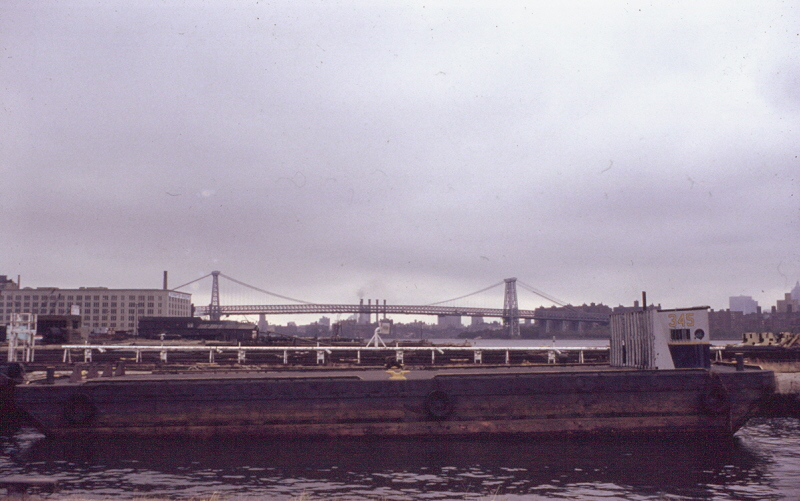
Scow #345 (ex-B&O) - October
1982 - North 9th Street, Brooklyn, NY
With BEDT centerpipe #32 behind.
The three yellow box bumpers on the right edge of the photo are from yet
another three track interchange carfloat on the far side
of the centerpipe carfloat.
unknown photographer
authors collection
added 06 March 2012
.
For unknown reasons there was a long involved process for the
transfer of copper ingots arriving via the Brooklyn Eastern District Terminal
to Phelps - Dodge:
High cube boxcars loaded up to their haulage capacity with 750
pound copper ingots, arrived at Brooklyn Eastern District Terminal one three
track interchange carfloats. These boxcars were hauled off the three track
interchange carfloats, and transferred onto a modified station / platform
carfloat. Joe Roborecky recalls that this station carfloat was so modified,
in that the roof was raised to accommodate the opening of the plug doors
on high cube boxcars.
One empty boxcar with a fork lift inside was also loaded onto
the station carfloat, with the boxcars loaded with copper. This
carfloat was then moved slightly upriver from the float bridge at North
9th Street to north side of "9 Pier" (slightly north of the float bridge)
and moored to the pier. Then, one of the former B & O scows would be
moored against the station carfloat. Then the fork lift would take the copper
ingots out of the boxcars and set them down on the carfloat platform where
another (or the same) fork lift would stack the ingots on the scow!
When all the boxcars were unloaded and the ingots on the scow,
the scow was brought to Phelps - Dodge. Fortunately, this operation did not
occur every day, and I certainly hope not considering the labor involved!
And exactly why this procedure was needed is unclear. I can
only hazard a guess that perhaps there was bulk head crane at Phelps Dodge
to remove the stacks of ingots from the deck of the scow in bulk, and the
with the ingots loaded inside boxcars, they couldn't be accessed.
date built |
builder / |
official |
length |
beam |
draft |
|
gross tonnage |
net tonnage |
former owner |
|
|
"Charles H. Senff" |
|||||||||||
| 1882 | Brooklyn, NY |
120003 26003 |
91.4' | 22' | 11' | 357 | 147 | 100 | coal / steam | overhauled 10/26/1906 | |
| hull: wood; to the "Mary T. Tracy" of Tracy Towing Line, Philadelphia, PA | |||||||||||
|
|
|||||||||||
"Lowell M. Palmer" |
|||||||||||
| 1887 | Beafy & Levy Philadelphia, PA |
140893 | 91' | 22.5' | 10' | 350 | 119 | 59 | coal / steam | ||
| hull: wood; engine: compound; cyl: 20" & 24"; stroke: 26"; boiler: leg type, 9' dia x 14.6', 145 h.p.; working pressure: 125 p.s.i. | |||||||||||
|
|
|||||||||||
"Henry U. Palmer" |
|||||||||||
| 1891 | Philadelphia, PA |
96130 | 90.8' | 22' | 10.2' | 350 | 137 | 68 | coal / steam | ||
|
|
|||||||||||
"Industry" (1st) |
|||||||||||
| 1906 | Staten Island Shipbuilding, Port Richmond, NY |
390 / 203782 | 87' | 24' | 12' | 637 | 163 | 111 | steam | ||
| hull: steel; engine: compound;
cyl: 18" x 38"; stroke: 26"; boiler:
single ended scotch, 13.6' dia x 10.6', 145 h.p.; working
pressure: 150 p.s.i.
sold; renamed "Carrie T. Meseck", "Delaware", "Manie L. Piner", "Bull", "Sea Star". Dieselized unknown date. |
|||||||||||
|
|
|||||||||||
"Invincible" |
|||||||||||
| 1913 - 1956 > | Skinner Shipbuilding, Baltimore, MD |
211825 | 95.1' | 26.3' | 12.1' | 850 | 231 | 135 | steam | ||
| hull: steel; engine: compound; cyl: 19" x 40"; stroke: 28"; boiler: single ended scotch, 15.3' dia x 12.6', 180 h.p.; working pressure: 165 p.s.i. | |||||||||||
|
|
|||||||||||
"Industry" (2nd) |
|||||||||||
| 1918 - 1960 > | Green Bay, WI |
217301 | 95.5' | 24' | 13' | 500 | 192 | 100 |
US Shipping Board |
bunker oil / steam | 500 ihp 2cyl compound sank 1930, raised sank East River 1947; raised |
|
|
|||||||||||
"Integrity" (2nd) |
|||||||||||
| 1918 - 1962 > | Green Bay, WI |
217302 | 95.5' | 24' | 13' | 500 | 192 | 100 |
US Shipping Board |
bunker oil / steam | 500 ihp 2cyl compound |
|
|
|||||||||||
"Integrity" (3rd) |
|||||||||||
| 1930 (1964 - 1970) |
Pusey & Jones Wilmington, DE |
230267 | 195 |
Erie |
I-R diesel / electric | ||||||
|
|
|||||||||||
"Intrepid" (2nd) |
|||||||||||
| 1930 (1962 - ?) |
Pusey & Jones Wilmington, DE |
230416 | 195 |
Erie |
I-R diesel / electric | ||||||
|
|
|||||||||||
"Olean" |
|||||||||||
| 1930 | Erie |
I-R diesel / electric |
did not enter BEDT service - |
||||||||
|
|
|||||||||||
| "Petro Arrow" | [1972-1977 (78?) ] | ||||||||||
| "Williamsburgh" | [1978-1979] | ||||||||||
| "Brooklyn III" | [1979-1983] | ||||||||||
this vessel not to be confused with
the N.Y. Dock "Brooklyn III"; |
|||||||||||
| 1953 (1972 -1983) |
Jakobson Shipyard Oyster Bay, LI, NY |
266145 / 344 |
106' | 26' | 12' | 1590 | NYNH&H: "Cordelia"
NYNH&H:
Penn Central: |
Cleveland diesel / electric |
(sold / scrapped 1996) | ||
| Petro Arrow
port of registry: Philadelphia, PA. Unknown at this time why this is, or
to whom registered. Please refer to Equipment Footnotes for bicentennial paint scheme. |
|||||||||||
|
|
|||||||||||
"Petro Flame" |
[1972 - ? ] | ||||||||||
"Greenpoint" |
[ ? - ca. 1978] | ||||||||||
"New Jersey" |
[1979 - 1983] | ||||||||||
| 1953 (1972 -1983) |
Jakobson Shipyard Oyster Bay, LI, NY |
265688 / 345 |
106' | 26' | 12' | 1590 |
NYNH&H:
NYNH&H:
Penn Central: |
Cleveland diesel / electric |
(became Cross Harbor I) sold: Eastern Towboat for sale: 2005 sold: 2007 to Rhode Island Yacht Club as moored breakwater, sunk |
||
| Petro Flame port of registry:
Philadelphia, PA. Unknown at this time why this is, or to
whom registered. Please refer to Equipment Footnotes for bicentennial paint scheme. |
|||||||||||
There is a lot of confusion regarding
the NYD & BEDT tugboats named "Brooklyn III".
The Thomas Flagg and Jay Bendersky books
use a numbering method: "Brooklyn III (1) and Brooklyn III (2),
but this could lead one to believe that the New York Dock had two separate
tugs named Brooklyn III throughout their history; and the BEDT had two separate
tugs named Brooklyn III throughout their history; for a total of four vessels;
and this is not the case. Therefore, in my opinion; by calling them the Brooklyn
III (1) and Brooklyn III (2) confuses matters.
As BEDT and NYD theoretically remained separate entities with
separate logos, I feel it is simpler to regard and refer to each vessel as
to the owner, i.e.: the "NYD Brooklyn III" and the "BEDT Brooklyn III".
At no time did these two vessels operate in New York Harbor bearing the same
name at the same time.
Simply put and in chronologic order (oldest name first):
the NYD "Brooklyn III" was the: |
...||... | the BEDT "Brooklyn III" was the: |
||||
| ex-Erie | "Marion" | ...||... | ex-New York, New Haven & Hartford | "Cordelia" | ||
| ex-Crescent Towing | "Marion Smith" | ...||... | ex-New York, New Haven & Hartford | "Transfer No. 23" | ||
| acquired by NYD and named | "Brooklyn III" | 1978 | ...||... | acquired by BEDT and named | "Petro Arrow" | 1972 |
| renamed by NYD to | "New York" | 1979 | ...||... | renamed by BEDT to | "Williamsburgh" | 1978 |
| ...||... | renamed by BEDT to | "Brooklyn III" | May 1979 | |||
. |
...||... | |||||
did not have canopy on deck aft of wheelhouse, |
...||... ...||... |
had canopy on deck
aft of wheelhouse, had BEDT Marine (tapered red & white flag) herald on stack |
||||
Please do not misunderstand
me, I am quite appreciative of all the research work previous historians
have accomplished. It took me several readings to get the history straight.
I felt it would be simpler to list as I have done above, and others
agree.
I am always seeking detailed technical
specifications and build info for all BEDT Tugs not already listed -
If you have or know where it can be obtained, please contact me at
BEDT14@aol.com
| number | configuration | official and/or construction # | shipyard | hull laid | launched | delivered | info | notes | ref. |
| #1 | ca. 1900-1917 | wood hull, 230' | |||||||
|
|
|||||||||
| #2 | 162867 | Noank, CT | 1906 | wood hull, 276-278' gr. tonnage: 853 |
[1] | ||||
|
|
|||||||||
| #3 | ca. 1891-1897 | wood hull, 221-225' | |||||||
|
|
|||||||||
| #4 | ca. 1891-1897 | wood hull, 221-225' | |||||||
|
|
|||||||||
| #5 | 164065 / 101 | NY Shipbuilding Camden, NJ |
2 Mar 1910 | 20 Apr 1910 | 25 Apr 1910 | steel hull, 256-258' gr. tonnage: 792 |
[1] [5] |
||
|
|
|||||||||
| #6 | platform | 165480 | NY Shipbuilding Camden, NJ |
17 July 1913 |
13 Sep 1913 |
19 Sep 1913 | steel hull, 256-258' gr. tonnage: 825 |
[1] [5] |
|
|
|
|||||||||
| #7 | 165041 / 133 | NY Shipbuilding Camden, NJ |
3 Jul 1912 | 30 Sep 1912 | 5 Oct 1912 | steel hull, 256-258' gr. tonnage: 873 |
[1] [5] |
||
|
|
|||||||||
| #8 | ca. 1891-1897 | wood hull, 221-225' | |||||||
|
|
|||||||||
| #9 | 162858 | Noank, CT | 1906 | wood hull, 276-278' gr. tonnage: 853 |
[1] | ||||
|
|
|||||||||
| #10 | ca. 1891-1897 | wood hull, 221-225' | |||||||
|
|
|||||||||
| #11 | ca. 1900-1917 | wood hull, 230' | |||||||
|
|
|||||||||
| #12 | ca. 1900-1917 | wood hull, 230' | |||||||
|
|
|||||||||
| #13 | 146 | NY Shipbuilding Camden, NJ |
29 July 1913 | 04 Sep 1913 |
28 Sep 1913 |
steel hull | [5] | ||
|
|
|||||||||
| #14 | three track interchange | 164873 / 128 | NY Shipbuilding Camden, NJ |
1 Feb 1912 | 26 Mar 1912 | 3 Apr 1912 | steel hull gr. tonnage: 807 |
[1] [5] |
|
|
|
|||||||||
| #15 | 166793 | Brooklyn, NY | 1890 | wood hull, 253' gr. tonnage: 484 |
[1] | ||||
|
|
|||||||||
| #16 | 166978 | Brooklyn, NY | 1890 | wood hull, 253' gr. tonnage: 425' |
[1] | ||||
|
|
|||||||||
| #17 | 268 | NY Shipbuilding Camden, NJ |
6 Apr 1922 | 24 May 1922 | 27 May 1922 | steel hull | |||
|
|
|||||||||
| #18 | three track interchange | 269 | NY Shipbuilding Camden, NJ |
4 May 1922 | 31 Jul 1922 | 3 Aug 1922 | steel hull | in service as of 11/1964 |
[2] |
|
|
|||||||||
| #19 | 275 | NY Shipbuilding Camden, NJ |
19 Oct 1922 | 14 Dec 1922 | 19 Dec 1922 | steel hull | in service as of 11/1964 |
[2] | |
|
|
|||||||||
| #20 | three track interchange | 276 | NY Shipbuilding Camden, NJ |
21 Nov 1922 | 4 Jan 1923 | 4 Jan 1923 | steel hull | in service as of 11/1964 |
[2] |
|
|
|||||||||
| #21 | three track interchange |
277 | NY Shipbuilding Camden, NJ |
20 Dec 1922 | 1 Feb 1923 | 12 Feb 1923 | steel hull | in service as of 11/1964 |
[2] |
|
|
|||||||||
| #22 | three track interchange | 370 | NY Shipbuilding Camden, NJ |
17 Mar 1927 | 16 May 1927 | 21 May 1927 | steel hull | in service as of 11/1964 |
[2] |
|
|
|||||||||
| #23 | three track interchange | 1948 | 17 cars steel hull |
in service as of 11/1964 |
[2] | ||||
|
|
|||||||||
| #24 | three track interchange | 1948 | 17 cars steel hull |
in service as of 11/1964 |
[2] | ||||
|
|
|||||||||
| #25 | platform | 1948 | 12 cars steel hull "bicentennial carfloat" |
in service as of 11/1964 leased to New York Cross Harbor 8/1983; returned to NYD Properties |
[2] [4] |
||||
|
|
|||||||||
| #26 | platform / center pipe |
1940 | 12 cars steel hull Schaefer Brewery carfloat |
in service as of 11/1964 |
[2] [3] |
||||
| This platform carfloat was converted
post 1972 to a center pipe configuration for use at the Schaefer
Brewery. (reference photo in marine paragraph on Bush Terminal webpage) The platform from this carfloat was placed at North 9th Street and used as a truck to boxcar loading platform. |
|||||||||
|
|
|||||||||
| #27 | three track interchange | 1940 | 12 cars | middle track removed | [6] | ||||
|
|
|||||||||
| #28 | three track interchange | 1953 | 22 cars | leased to New York Cross Harbor 8/1983; returned to NYD Properties |
[6] | ||||
|
|
|||||||||
| #29 | three track interchange | 1953 | 22 cars | sold to New York Cross Harbor 8/1983 |
[6] | ||||
|
|
|||||||||
| #30 | three track interchange | 1954 | 22 cars | sold to New York Cross Harbor 9/1983 |
[6] | ||||
|
|
|||||||||
| #31 | special platform | 1940 | 14 cars | [6] | |||||
| This
carfloat had an elevated platform or "flying bridge" above the
normal carfloat platform roof. Also steep steel steps from the
carfloat deck led up to the flying bridge. Accessed by this flying
bridge was a small swivelling davit with pulley, for possibly lifting a hose or hoses. It is believed this flying bridge was hastily constructed on this carfloat to initally start direct from carfloat service for the Schaefer Brewery, with the flying bridge used to make the connection to the double siphon pipe overhanging the Schaefer Brewery bulkhead, until the centerpipes #26 & 32 were completed, but this is unconfirmed. |
|||||||||
|
|
|||||||||
| #32 | center pipe | 1940 | steel hull 10 cars Schaefer Brewery carfloat |
ex-PRR #588 seen in images dated 1976 Greenville, and 1982 at BEDT Bulkhead |
|||||
| This carfloat
is seen in Greenville, NJ next to the Petro Arrow in 1976, and tied up at
Kent Avenue afterwards. This carfloat has boxed track bumpers,
and not Hayes style as seen on BEDT centerpipe carfloat #26. Nor do the track bumpers of this carfloat match those on the Lehigh Valley centerpipe carfloat either. Therefore it is know believed that #32 is a third centerpipe carfloat used for Schaefer Brewery service. Furthermore, this carfloat has "button" style bitts which were standard appliances on almost all Pennsylvania RR marine equipment. Coincidentally, seeing how a surplus carfloat platform bearing the number 588 is seen in images dated after 1975 at Pidgeon Street, it is believed that BEDT centerpipe carfloat #32 was converted from PRR station carfloat #588, and the platform used like that of Carfloat #26: as a truck to boxcar loading platform. |
|||||||||
|
|
|||||||||
| #64 | three track interchange | [6] | |||||||
|
|
|||||||||
| #70 | three track interchange | 1930 | 17 car capacity | ex-Penn Central exx-New York, New Haven & Hartford |
[6] | ||||
|
|
|||||||||
| #72 | three track interchange | 1957 | 17 car capacity | ex-Penn Central exx-New York, New Haven & Hartford |
[6] | ||||
|
|
|||||||||
| #80 | three track interchange | 1953 | 22 car capacity | possibly purchased directly by BEDT, sister to BEDT #28, 29, 30 |
[6] | ||||
|
|
|||||||||
| #84 | three track interchange | 1954 | 22 car capacity | ex-Penn Central exx-New York, New Haven & Hartford |
[6] | ||||
|
|
|||||||||
| #189 | platform | 1930 | 12 car capacity | ex-Baltimore
& Ohio acquired by New York Dock 9/20/1976 o.o.s. 9/29/1977 |
[6] | ||||
|
|
|||||||||
| #197 | platform | 1951 | 12 car capacity | ex-Baltimore &
Ohio acquired by New York Dock 9/20/1976 |
[6] | ||||
|
|
|||||||||
| #207 | platform | 1955 | 12 car capacity | ex-Baltimore &
Ohio acquired by New York Dock 9/20/1976 |
[6] | ||||
|
|
|||||||||
| #209 | platform | 1956 | 12 car capacity | ex-Baltimore &
Ohio acquired by New York Dock 9/20/1976 |
[6] | ||||
|
|
|||||||||
| #210 | platform | 1957 | 10 car capacity | ex-Baltimore &
Ohio acquired by New York Dock 9/20/1976 o.o.s. 9/29/1977 |
[6] | ||||
|
|
|||||||||
| #211 | platform | 1956 | 12 car capacity | ex-Baltimore &
Ohio acquired by New York Dock 9/20/1976o.o.s. 9/29/1977 |
[6] | ||||
|
|
|||||||||
| #212 | platform | 1956 | 12 car capacity | ex-Baltimore &
Ohio acquired by New York Dock 9/20/1976 |
[6] | ||||
|
|
|||||||||
| #214 | platform | 1957 | 10 car capacity | ex-Baltimore &
Ohio acquired by New York Dock 9/20/1976 |
[6] | ||||
|
|
|||||||||
| #215 | platform | 1957 | 12car capacity | ex-Baltimore &
Ohio acquired by New York Dock 9/20/1976 o.o.s. 9/29/1977 |
[6] | ||||
|
|
|||||||||
| #216 | platform | 1957 | 12 car capacity | ex-Baltimore & Ohio acquired by New York Dock 9/20/1976 |
[6] | ||||
| Platform roof raised to clear hi cube boxcar plug doors 8/8/1978. Work was performed by BEDT shop employees at north side of North 9th Street Pier. | |||||||||
|
|
|||||||||
| #218 | platform | 1957 | 12 car capacity | ex-Baltimore &
Ohio acquired by New York Dock 9/20/1976 o.o.s. 9/29/1977 |
[6] | ||||
|
|
|||||||||
| LV #? | center pipe | Schaefer Brewery carfloat |
[6] | ||||||
| This carfloat can be seen in
the photo taken by Jay Held and on page 60 of "New York Harbor Railroads
in Color, Vol. 2" by Tom Flagg. It appears to have wood rub rails. The disposition of this carfloat is not known, but if this Lehigh Valley RR carfloat was at the end of its service life, it is possible however unlikely, BEDT removed it's centerpipe and platform and transferred this equipment to the PRR #588 carfloat (becoming BEDT #32), but this unconfirmed. Furthermore, this carfloat may not have ever been transferred or sold to BEDT. |
|||||||||
|
|
|||||||||
| #232 | scow | ex-Pennsylvania RR acquistion details unknown (seen in 10/10/1977 pic with BEDT #25) |
[6] | ||||||
|
|
|||||||||
| #345 | scow | 400 ton capacity | acquired from Baltimore & Ohio RR used for transport of copper for Phelps-Dodge, Newtown Creek, Queens, NY |
[6] | |||||
|
|
|||||||||
| #350 | scow | 400 ton capacity | acquired from Baltimore & Ohio RR used for transport of copper for Phelps-Dodge, Newtown Creek, Queens, NY |
[6] | |||||
| number | configuration | official and/or construction # | shipyard | hull laid | launched | delivered | info | notes | ref. |
Carfloat Footnotes
[1]
= ascertained from Merchant Sailing Vessels
of the United States, 1920
[2]
= as listed on Daily Report
of Towing, for Intrepid, November 28, 1964
[3]
= converted from a two
track station carfloat
[4]
= please refer to Equipment
Footnotes, Bicentennial Celebration
[5]
= ascertained from
New York Shipbuilding Historical Site
[6]
=
information comes from Benjamin W. Schaeffer, which in turn was
received during a telephone call with Mark S. Balkin, in 1978. Information
had been compiled by Mr. Balkin for an intended article on New York Dock
Railway but upon Mr. Balkin's death, went unpublished. This information
has now been collated by myself and Mr. Schaeffer and published here. As
some of these acquistion too place after the BEDT / NYD merger on 1978, this
information is published on the New York Dock page as well.
Non-Revenue & Miscellaneous
Equipment Roster & Photos
You will notice the unusual equipment
at the top of the following list. These items (including the horse) are listed
on a 1927 ICC valuation report.
| car # | description | service dates |
| horse (the hay eating kind!) | ||
| work equipment, floating stage, | built 1916 | |
| work equipment, floating pontoon, | built 1916 | |
| Ford truck, 1 ton, | built 1918 | |
| Ford touring car, | built 1919 | |
| dump cart, 2 wheel, dump body, 2 cu yd capacity | ca. 1927 | |
| truck mounted crane(s) | 1950's-1980's | |
| X6 | tank car | ca. 1930's - ? |
| X7 | tank car | ca. 1940's |
| X11 | tank car | ca. 1964 - 1983? |
| X12 | tank car | ca. 1950's - ? |
| X11 | derrick car | ca. 1970's - 1973? |
| X14 | idler / reach Car | ca. 1963 - ca. 1965 |
| wood boxcar (tool car) | ca. 1960's | |
| bicentennial boxcar | 1976 - 1997 | |
| N5 type caboose | ca.1972 - 1983 |
With the exception of the N5 Type caboose which is currently
painted blue and located at the Bush Terminal Yard of NYNJ Rail Corp in
Brooklyn; and BEDT #25 (in New York Central livery), it is understood
than no other pieces of BEDT Non-Revenue Equipment equipment survive.
According to Benjamin W. Schaffer, the caboose was purchased
from New York Dock and was one of a group of three cabooses purchased by
New York Dock from Penn Central circa 1968. It is understood to have suffered
a minor fire but when exactly is unknown. During tenure at New York Dock,
it is unknown if it was used. If one takes notice, the caboose is first seen
at BEDT in the same dark "New York Dock green" with black roof and yellow
rungs as C58 above, so it is understood New York Dock at the least, painted
the caboose. Due to this, and according to anecdotal information supplied
to Benjamin W. Schaeffer, this caboose is almost certainly to have been from
the NYD group of three cabooses.
This caboose still survives and is located in New York New Jersey
Rails' Bush Terminal in New York Cross Harbor livery. Its service history
throughout the years (after it's service on BEDT) can be read on the
New York Dock,
New York Cross
Harbor and
New York New
Jersey Rail pages of this website.
On January 27, 2012, John Taubeneck submitted information on
rail cranes located in the New York area. The following entry was
noted:
Ohio Locomotive Crane |
Miscellaneous Equipment
Footnotes
.
.
Bicentennial Celebration
In preparation for Operation Sail, and for the celebration of the 200th Anniversary of the United States, BEDT diesel locomotive #25, the tugboats Petro Flame and Petro Arrow, Carfloat #25, along with the steel boxcar (of undetermined origin), would be painted red, white & blue in 1976.
BEDT #25 would wear her Bicentennial scheme until about 1984, when it was repainted by it's new owners, the New York Cross Harbor Railroad. The tugboats, would wear their Bicentennial dress through their transition into the names "Greenpoint" and "Williamsburgh", and until circa 1978, when both vessels would be repainted and renamed "New Jersey" and "Brooklyn III", which is the time when New York Dock purchased the BEDT equipment & properties.
The BEDT Bicentennial boxcar retained it's red, white & blue scheme until it presumably scrapped in 2001, as it simply ceased to exist after standing the Greenville, NJ yards for several years.
As for Carfloat #25, it's disposition in unknown. To the best of our knowledge, the New York Cross Harbor Railroad did not operate Carfloat #25 or any other of BEDT's station carfloats.
 |
![[Image]](http://members.trainweb.com/bedt/bedt/8.gif) |
 |
 |
 |
 |
 |
 |
 |
||
| . | ||||||||||
![[Image]](http://members.trainweb.com/bedt/bedt/21.jpg) |
![[Image]](http://members.trainweb.com/bedt/bedt/22.jpg) |
![[Image]](http://members.trainweb.com/bedt/bedt/23.jpg) |
![[Image]](http://members.trainweb.com/bedt/bedt/24.jpg) |
![[Image]](http://members.trainweb.com/bedt/bedt/25.jpg) |
![[Image]](http://members.trainweb.com/bedt/bedt/26.jpg) |
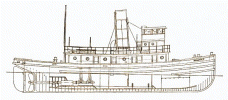 |
||||
. |
||||||||||
viewing |
||||||||||